
Oct 20, 2022 | aging, aging in place, cost of aging, cost of long term care, finances for elders, financial advisors
Carolyn L. Rosenblatt, RN, Attorney, AgingParents.com
Every year since 2004, private long term care insurer, Genworth has conducted a national survey to determine the average costs of care at home, and in facilities. The data is broken down by state, with the median price listed. The bottom line: the cost of care is rising significantly in all the four general areas Genworth studied. It is also rising in the areas it did not study. Inflation is affecting how much it costs elders and families to keep them at home or in any living situation. The Genworth study includes home care, adult day health, assisted living and nursing homes. There is a lot more to consider than what the Genworth study shows. Long-term care is not limited to the things this insurer pays for when you buy a product from them.
The median monthly costs in the U.S. for two of the services studies are outlined in the 2021 report from Genworth:
Homemaker services (help with cooking, cleaning, transportation, shopping, etc.) $4957
Home Health Aide (personal care: eating, bathing, dressing, walking, bathroom, etc.) $5148
In a book we wrote for financial planners, Hidden Truths About Retirement & Long Term Care (AgingInvestor.com, 2017), we detail how about 70% of us are going to need some kind of long term care in our lives. And we discuss how most of us live in The Great American Fantasy that it won’t happen to us, that we will be fine and die quietly in our sleep at age 100 in full control of our faculties. In the book, we urge financial advisors to help clients get out of fantasy and into the reality that dollars need to be set aside to pay for what Medicare does not cover; so called “custodial care” that is not medical in nature. That includes things like home care workers, home modification to accommodate disabilities, assisted living and other things many people eventually need. We discuss the advantages and disadvantages of all the choices.
Here are actual costs we learned about from clients in two real cases.
Four Years of Home Care
One of them, described in our book from 2017, was about a man who lived to be 95 and never wanted to be in a facility. His wife hired caregivers to keep him at home. Long term care insurance defrayed some of the cost but most came out of pocket. The bill for the 24/7 care he received over four years of increasing dependency: $2M. There was nothing unusual about his needs. He just got more frail and had more care issues over time. That’s typical of how some of us are going to age. At the end, he had four caregivers in shifts, a specially fitted van with special wheelchair, a home stair chair, a lift to get him into the bath, numerous other kinds of devices to help and huge increases in the cost of maintaining the home with all the help. That cost would be significantly higher in today’s dollars.
The Outrageous Cost Of A Difficult Elder’s Care
In another, current case we work with at AgingParents.com, there is an elder with unusual needs. The family has a very difficult mother with dementia. She is calm until certain personal care must be given. Her mental state is confusion. She hallucinates and thinks she is being attacked when the family member or paid caregiver attempts to clean or bathe her. She gets very combative, with kicking, biting and punching those next to her. She calms down after the personal care but it takes two people to keep her from hurting anyone. She is astonishingly strong for a woman in her 80s. Her physical assaults happen multiple times a day when she needs cleanup. The family will not put her into a care home. No home would accept her this way. Rather, they would medicate her into a stupor so she would be more manageable. The family won’t have that. Her lighter medication at home allows her to be engaged with those around her in a good way. All except at those time of the close personal care.
This family is paying $50,000 a month for home care workers from two different agencies to help them. They can’t do it alone. They can’t manage with just one caregiver at a time. It takes two at a time to do the job. The cost is draining their assets and there is no end in sight. As this keeps up, the family will be spending $600,000 in 2022 to care for their mother.
Assuredly, not every elder is as difficult as the combative and confused mother in this case. But some elders do become very hard to care for. If one has strong feelings about not over-medicating a loved one, the choices can get very expensive.
It can take a good strategy to manage the care of an elder at home. It is not as simple as just buying long-term care insurance when the elder still can qualify for it. It may take working with a competent financial planner who understands that the limited things this insurance pays for do not fully protect anyone from out-of-pocket costs. Many additional things may be needed to maintain an aging loved one at home, where most people want to be. Financial planners tend to promote having income to pay for “the lifestyle to which you are accustomed”. No one is accustomed to a lifestyle of needing 24/7 care at home. However that is a reality anyone needs to discuss with a competent financial advisor, as it can happen to any of us.
Overall, this is a wake-up call for anyone who has not thought through how to pay for long term care. If it is your own aging loved one, you can’t ever be sure that they won’t need assistance from a paid source in the future. If it is yourself, at or near retirement age, be wise about how you look at the need 70% of us may have as we get older. Long-term care can be simple for some. It can be a huge, heavy burden for others. The wise retiree will consider the risks of getting old, living long and the likely need for paid help at some time in their future.

Dec 30, 2020 | aging, aging in place, aging investor, cost of aging, cost of long term care, elder investor, elderly, finances for elders, financial advisors, handling money for seniors, investor, long term care, medicare, retirement planning, senior investor, seniors finances
In retirement planning discussions, we see this statement financial professionals often publish for their clients:
“The average lifetime out of pocket costs for healthcare for a 65 year old couple retiring today is $285,000.”
Why should you never say this? It’s misleading at best and at worst, it’s false. From my own research as to where the number came from, I found it in government sources calculating Medicare deductibles and supplemental insurance payments, and co-pays Medicare does not cover. Generally, the out of pocket calculation refers to non-covered “medical” costs. But when that term gets diluted to mean “healthcare” it is far too broad and it simply ignores the reality that long term care is indeed healthcare. Medicare does not cover that at all, except for limited stays in skilled nursing homes following hospitalizations. It is noteworthy that when the Federal government uses data to calculate what out of pocket medical costs will be, the subject of long term care is entirely omitted.
The “average” lifetime cost of long-term care for two people in this country is far greater than $285,000. According to research by long term care insurance provider, Genworth, seven in ten people will need long term care at some point in their lives.
The comprehensive Genworth cost of care study, done annually, was published for 2020. Consider that at some point, with longevity being as it is, an older person with multiple medical conditions may need 24/7 care. Almost everyone will tell the advisor that he or she wants to stay at home and age in place. What will that cost at home in any of the most expensive states? In California, for example, the median cost of in-home care with a non-licensed caregiver full time, 27/7 is $252,000 per year! This is not medical care, in the sense that no skilled nursing is part of it, no doctor’s prescription is involved, and the agencies that supply unlicensed home care workers can charge whatever the market will bear.
A truthful financial professional will never mislead aging clients, or those planning for retirement by telling them that all they have to worry about for their future out of pocket healthcare costs is $285,000. Prudent financial advisors will themselves look annually at the Genworth study and help clients calculate the costs of long-term care, which every person should know about.
Costs of care, whether at home, in an adult day health center, in assisted living or in a skilled nursing facility vary widely from state to state. Looking at national median costs can be of little benefit to anyone doing retirement planning. Instead, using data from the Genworth study, one can look state by state for the real, most applicable numbers derived from where your client lives or plans to retire.
From my perspective, financial advisors are not educated to fully understand the difference between government provided statistics about out of pocket, non-Medicare covered medical costs and what we mean by long term care. They are quite different terms. It is distressing to me, with substantial experience in nursing, to see the fallacy of statements published by financial professionals about what retirement planning should include. Clients will be shocked to find that their own experience with having to pay for long term care out of pocket is not what their own advisor told them years before.
If you are in the retirement planning business and you want to serve your clients well, bear in mind that the data telling us that seven in ten people will need long term care at some point is likely true. Don’t fool yourself into thinking that retirement planning is just fine if a couple puts away enough to generate $285,000 for out of pocket medical costs. They also need to plan for how to pay for long term care, which they are statistically likely to need. That cost can destroy the most carefully laid plans for retirement income.
As a real-life example, take a client of ours, “George” at AgingParents.com, where we offer advice and guidance to families with aging loved ones. The advice encompasses legal, financial and healthcare issues as well as diminished capacity issues. George is 98 years of age and still sharp, though with some memory loss problems. He was wealthy at one point, after two successful careers. He owns his own home and wants to stay there for the rest of his days. His physical health is fragile and he now needs 24/7 help. He hired a good agency to provide in-home care. He spends in excess of $300,000 a year for caregiving alone, not counting the cost of everything else involved in home ownership, food, recreation, and out of pocket medical costs. Those medical costs involve dental surgery and equipment he needs at home. He has less than $400,000 left in savings. What if he lives another two to four years?
As you can see from this example, George is not a rare case. Many people do live into their 90s and beyond. Many start out with financial security, only to see assets rapidly depleted as the cost of care escalates to heights no one wanted to think about in retirement planning.
The Takeway
If you pride yourself in doing great retirement planning with clients, get real. Sit down with the data and find out what your clients might expect to need if they live long and require help at home or elsewhere. Tell the truth about it. If they need long-term care insurance to feel secure, talk about it. If they have sufficient assets to make it to 100 or so with full time care, they don’t need to get long term care insurance but they will need to have access to sufficient cash to cover the actual, not fantasy, costs. Above all, be clear in your own mind about what “out of pocket medical costs” means as compared with long term care costs. You are the key to these honest calculations. You can be the hero of the retirement planning story when you present an honest picture to every client you have.
By Carolyn L. Rosenblatt, RN, Attorney, AgingInvestor.com
About Carolyn Rosenblatt and Dr. Mikol Davis
Carolyn Rosenblatt and Dr. Mikol Davis are co-authors of The Family Guide to Aging Parents (www.agingparents.com) and Succeed With Senior Clients: A Financial Advisors Guide To Best Practices and Hidden Truths About Retirement and Long Term Care. Rosenblatt, a registered nurse and elder law attorney, has more than 45 years combined experience in her professions. She has been quoted in the New York Times and, Wall Street Journal, Money magazine and many other publications. Davis, a clinical psychologist and gerontologist, has more than 44 years experience as a mental health provider. In addition to serving his patients, Davis creates online courses and products to assist professionals and the public with understanding aging issues. Rosenblatt and Davis have been married for 36 years.

Dec 8, 2020 | aging, aging in place, cost of aging, cost of long term care, financial advisors, handling money for aging parents, long term care, retirement, retirement planning
Few things are more stressful than family disagreements, especially related to helping an aging family member. You’re invited to a VIP Virtual Event: How to Resolve Family Conflicts, Care, Control and Money Approaches from Legal, Psychological and Compassionate Perspectives
Wednesday, December 9 I 4:00 – 5:00 pm Pacific Standard Time
Featuring special guest speakers Carolyn L. Rosenblatt, RN, Attorney and Dr. Mikol Davis, Psychologist of AgingParents.com
RSVP david@eleganceatnovato.com (Link will be provided with RSVP)
The first 20 attendees to RSVP will receive “The Family Guide to Aging Parents: Answers to Your Legal, Financial and Healthcare Questions,” 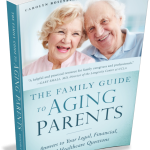 by Carolyn L. Rosenblatt.
by Carolyn L. Rosenblatt.

Nov 12, 2020 | aging, cost of aging, elderly, handling money for aging parents, handling money for seniors, nursing home
If you have any older clients, this real case is one you should know about. Here at AgingInvestor.com, where we also serve families of your clientele, we see some horror stories and this one should wake us all up. It really happened. We think it could have been prevented if only someone had acted sooner. The names are changed, but the facts are not. Imagine that this 83 year old man is your client. You’ve known him over many years. He is what some refer to as an “elder orphan”. He has no kids, He’s widowed and was always very independent. No one paid much attention to him as he aged. He had about $1M invested, and his advisor figured that at his rate of withdrawal, he would be fine, probably for his life expectancy. It never dawned on his advisor to ask about his safety at home, whether he needed any help day-to-day, or if he had identified a trusted contact. Right now, after horrible abuse lasting four years, he is lucky to be alive. “Tony” lived alone and took care of himself. But he was getting frail and it was getting hard to get the grocery shopping done. While at the market, a checker seemed to befriend him and asked if he needed help at home. He agreed that he did. What he didn’t know was that the checker, Mae, who had no caregiving experience, had targeted him. Her evil intent played out. Almost immediately after offering to help, she moved into his house. His advisor never asked about his relationships at the annual portfolio review, and the adage “know your client” was ignored. Mae swiftly got control over his life and finances. The help Tony needed became her weapon. She refused to take him to the doctor or dentist despite severe hip pain and dental problems. He needed food, but she deprived him until he did as she demanded, giving her Power of Attorney. She went so far as to force him to marry her, taking him to another city, and then threatening to dump him there unless he married her secretly. He was helpless to resist. Changes to the authorized signatory on his account happened, but the advisor thought nothing of it. He never asked. Tony appeared to be suddenly married, but the advisor just changed documents and never had a conversation with Tony about it, despite his being 83 at that time. As his “wife” Mae seized his bank accounts, pension deposits, safe deposit box with gold in it, and all of his valuables. She isolated him from everyone who knew him. He was cut off for years, trapped and not knowing how to escape. She hit him, left him in ragged clothing and threw his dog against the wall. He had some memory issues but he did remember he had nieces and nephews. When Mae was out of the house one day, he made a desperate call to his nephew, with whom he had been close in years back. He begged for help. The nephew sprang into action. He summoned his 3 siblings, including one out of state, and together, they rescued Uncle Tony and brought him home. Tony’s nephew knew a lawyer who got an emergency court order to remove the “wife” from Tony’s house. Mae had to be escorted out by the police who initially resisted because Tony and the caregiver were married. It was stunning how the police believed the evil caregiver and not Tony nor his family members. Even with a court order in hand, the police were hesitant to evict Mae. His two capable nieces took over and addressed his needs. One moved in with her uncle to protect him for good. Tony is safe at this time and Mae will never have access to him again. Lawsuits are pending. He may never get his money or valuables back but at least he has his home and some relatives to step in. Some elder orphans have no one. How did this happen while an advisor managing his account saw it being drained by his “wife” over time? This is the most important point of the story for any advisor with aging clients who are alone, with no nearby family to watch out for them. YOU the advisor need to be watching out. The Takeaways Tony, an “elder orphan” made an easy target. Think about your older investors. How many live alone and have no family? It is well worth your time to ask them. Five things every advisor should do with any older client who is living alone and has no family are these:
- Check in with your older clients as often as quarterly, rather than once a year. Ask questions about how things are at home. The $700,000 Mae stole from Tony could have paid for a lot of care or help at home.
- That suggestion by regulators that you should “try” to get a trusted contact for every client must not be an option. You must insist on getting a trusted contact, especially for elders. (We recommend you get more than one!) Elder orphans may not act promptly when suspicious activity comes up but you can. When Mae made constant withdrawals from Tony’s account, the trusted contact should have been called. He was 83. That’s a red flag by itself.
- Know your client. That means general living situation, whether any family is around, and some basics about their health and independence. It’s not nosy to ask. It’s part of your job.
Brutal people taking advantage of aging clients, as Mae did are out there looking for victims. When you know your client, and you are paying attention, you are like the family they don’t have: you can keep them safe. By Carolyn Rosenblatt, RN, Attorney, Consultant
|
|
Dr. Mikol Davis and Carolyn Rosenblatt, co-founders of AgingInvestor.com
Carolyn Rosenblatt, RN, Elder Law Attorney offers a wealth of experience with aging to help you create tools so you can skillfully manage your aging clients. You will understand your rights and theirs so you can stay safe and keep them safe too.
Dr. Mikol Davis, Psychologist, Gerontologist offers in depth of knowledge about diminished financial capacity in older adults to help you strategize best practices so you can protect your vulnerable aging clients.
They are the authors of "Succeed With Senior Clients: A Financial Advisors Guide To Best Practice," and "Hidden Truths About Retirement And Long Term Care," available at AgingInvestor.com offers accredited cutting edge on-line continuing education courses for financial professionals wanting to expand their expertise in best practices for their aging clients. To learn more about our courses click HERE
|

Oct 9, 2020 | aging, aging investor, elder investor, elderly, finances for elders, financial advisors, financial capacity, financial judgement, handling money for aging parents, senior investor
Financial professionals often use the term “financial wellness”, referring to a client’s comfort level with their assets in retirement. That sounds good. But is there any connection between finances and wellness of the body and mind in retirement? Perhaps there is a vague belief that if you’re financially secure, all is well. In reality, how much money you have does not automatically make you physically nor mentally well, nor does it protect anyone against the one thing many people fear most: Alzheimer’s disease. Dementias are no respecters of the wealthy. No one is immune to brain disease.
You may hear the well-worn adage, “Without your health, you have nothing”. OK, that’s not completely true either. Even with declining health related to aging, you may still have excellent quality of life. That is a matter of perspective, and a matter of using assets you have to make the most of life, even with disabling conditions. The one factor that makes for a more secure longevity is what you can afford in terms of care, as aging takes its toll on independence.
Research clearly shows that how we live our lives, our healthy habits or lack of them is responsible for about 70% of how we age. Aging is different for each person, with the other 30% of the picture directed by genetics. Suppose you have a client with longevity running in the family. That may affect your client’s life span but it will not guarantee a great “health span”; i.e., how long one is healthy. What we already see with our aging population is an increase in disabling illnesses in seniors coping with diabetes, heart disease, obesity, high blood pressure and yes, Alzheimer’s disease and other dementias. Genetically predisposed to live long? How fun can it be to live to be 100 if you have a combination of these illnesses, cutting off the things that make life worth living for most of us?
It is extremely unlikely that any financial professional is going to convince a client to lose weight, exercise, stop smoking or cut out junk food so they can enjoy retirement more. That’s not your job. Managing assets is your job and the assurance you can provide is that your client, with a strategically managed investment portfolio, will be able to afford high quality care in old age.
What does high quality care mean for one’s retirement years? It means that if enough assets are available, your client will never have to go to a nursing home. It means that they can afford well trained caregivers at home from high quality agencies, licensed, bonded and insured.
Here’s an example from real life with one of our clients at AgingParents.com, the companion site to AgingInvestor.com. Timothy is 97 years old, living in a lovely home he’s been in since 1960. He is widowed. He needs a walker. He doesn’t cook for himself. He’s very alert but with lung disease, he’s frail. He has a high-end agency providing care management as well as caregivers day and night. He has the means and the right to spend his last days in his own home. Even if his health deteriorates further, he can afford a Registered Nurse to oversee his treatment or give additional skilled care to him at home. Licensed home health agencies can give skilled nursing to anyone at home for a price. A concierge physician can also visit him at home and direct the medical treatment for any illness or chronic condition. That is high quality care, and it comes only at a high quality price.
If you are in the business of managing client assets as they age, don’t just talk about how fun retirement will look at age 90 because they have plenty to spend. That may not be true at all if health is an issue. At that age, declining health is usually problematic. Be truthful. Let your clients know about how you are working to protect them in longevity, no matter what health conditions they may face. That protective spirit feels good to people, knowing you’re watching out for them and that you support the notion of staying in one’s home to the end of life. You have foresight they may lack. And you know the dollars they’ll need for what is likely to become necessary with long life.
If you do not know details of just what dollars those are, the nuts and bolts of how much it actually costs to pay for the numerous kinds of care a person may need, you can quickly find out. It’s laid out for you in our book, Hidden Truths About Retirement & Long Term Care, available at AgingInvestor.com and on Amazon. Increase your expertise! Get your copy today by clicking here
By Carolyn Rosenblatt, RN, Attorney, AgingInvestor.com and AgingParents.com

Nov 13, 2019 | ageist, aging, aging investor, declining health, diminished cognition, elder investor, elderly, finances for elders, financial advisors, financial capacity, financial judgement, handling money for aging parents, handling money for seniors, investor, retirement, senior investor, seniors finances
At its Senior Protection Conference on November 12, 2019, FINRA took a cell phone poll of broker-dealers. They wanted to find out how many were worried about aging registered representatives at their firms. The result: 65% were worried, according to the report published in Financial Advisor. Yes, aging B-Ds are a problem.
Here at AgingInvestor.com, we’ve been sounding the alarm about this problem since 2016, when we published our book, Succeed With Senior Clients: A Financial Advisor’s Guide to Best Practices. “The Elephant in the Room” chapter dives into how impairment in advisors affects the industry and how that most definitely will affect their work with clients. A B-D or advisor whose memory and judgment are impaired, even in the early stages, can expose the firm to liability for mistakes these folks make. Cognitive decline should not be taken lightly.
The speakers at the conference offered attendees very little concrete advice on how to address the problem of an impaired advisor. What could one expect of them? They have no training nor skill set in identifying diminished capacity themselves. Without expertise, their discussions lack action plans.
As aging experts ourselves (RN, Elder law attorney and geriatric psychologist) and a resource to the industry, we question the suggestion that one should wait for “performance issues” to surface before any firm does anything about an impaired professional in its midst. If there is a “performance issue” visible to management, it is likely that it existed for some time and harm to clients already could have occurred. The notion is reactive, not proactive. Isn’t that contrary to the essential philosophy of financial planning itself to look ahead, strategize and don’t wait for a crisis??
Waiting for a manager to call a special team assigned to address the problem is not the best approach, as we see it. For one thing, most firms don’t have a special team that would serve the purpose of knowing what to do with an impaired advisor. Yes, every firm would be well protected if such a team were formed and that is something we always recommend. However, failing to screen advisors with any in-house tools when impairment is suspected is to ignore the lurking possibility of harm to clients. What do we mean by an in-house tool? Start with a checklist.
On our website is a free downloadable Financial Advisor’s Checklist: 10 Red Flags of Diminished Capacity to help you spot the warning signs in clients. There is no reason any firm could not use relevant parts of the same tool to spot signs of diminished capacity in its own employees. It is not across-the-board applicable to the professional as compared with a client showing red flags but some points do apply to anyone. For example, memory loss, failure to appreciate the consequences of decisions, confusion, loss of ability to process basic concepts are all on the checklist and are universal warning signs.
What Can You Do With An Advisor You Think Is Impaired?
Proactive steps are essential. Here are our recommendations:
- First, record your observations of changes in the advisor’s behavior. For example, forgetting appointments, failure to meet on schedule with clients, seeing too many blank stares in your interactions with him or her, becoming withdrawn from interactions can all be signs of trouble a manager must address. They could be associated with cognitive impairment or with other health conditions. Managers need to ask the advisor about what they and other colleagues see that looks like a possible red flag.
- Ask about general health issues, which can directly impact how an advisor does the job of handling clients. Is it nosy? Yes. Is client financial safety at stake if you don’t ask? Yes. Take the risk of opening the conversation. That is smart. Waiting for a disaster is not.
- Establish an in-house policy for what should be recorded by colleagues and reported to managers about possible signs of cognitive decline and the direction you want to take after signs are identified. The policy should be in writing and distributed.
- Have a plan to closely watch the apparently impaired advisor.
Asking the advisor to work with someone to supervise transactions is one option. Reviewing how the advisor is managing his or her work at short intervals is another option. And with obviously impaired folks who do not themselves recognize their own cognitive changes (not an uncommon thing), have a suspension or graceful exit means to stop the impaired person from putting clients at risk. This falls under what those conference speakers vaguely referred to as “other arrangements”. Be specific.
This is uncomfortable territory for managers, compliance officers and for colleagues of older advisors in firms. However, the FINRA poll is telling. If this problem were not rising in our midst, 65% of those polled would not be worried. If you are concerned where you work, get your copy of Succeed With Senior Clients: A Financial Advisor’s Guide to Best Practices, now or get a live or online presentation from us at AgingInvestor.com. Don’t put your firm and your clients at unnecessary risk.
By Carolyn Rosenblatt, RN, Elder law attorney, Consultant, AgingInvestor.com

Sep 5, 2019 | aging, aging investor, cost of aging, declining health, diminished cognition, elder investor, elderly, finances for elders, financial advisors, financial capacity, financial elder abuse, financial judgement, handling money for seniors, investor
Attempts to scam money from seniors never stop. And the thieves keep getting better at thinking up ways to extract information from older folks. Here’s another one—a different phony Medicare trick.
People hear ads on TV about genetic testing and how it can predict disease and protect them. They also hear ads that they’re not getting all the Medicare benefits they deserve. Who doesn’t want to get all the benefits they should get? It’s a perfect moment for scammers.
They may call your retirement-aged client and tell them that new genetic testing is available that Medicare will pay for, worth thousands of dollars. Of course, all your client has to do is to give them their Social Security number and the free testing kit, signup papers, or other inducement will be mailed to them immediately.
Let’s be clear: Medicare does not pay for genetic testing as a “new benefit”. If for any reason such testing were needed, a physician would order it and explain why it was needed. Such testing would not be ordered without any discussion with one’s MD.
Your client should never, ever give out a Social Security number or other personal information such as date of birth or address over the phone. Your client must never accept a genetic testing kit not ordered by one’s own doctor. If it is accepted and the cheek swab, DNA test or anything else is given to the sender, your client may be billed directly, potentially incurring a debt for thousands of dollars. It would be a sad day for your client to mail in a claim for reimbursement to Medicare for a fake benefit and realize that the claim is denied. They’re on the hook for the full price.
These kinds of scams are used to get information to commit identity theft and Medicare fraud. No matter how smart your client is, anyone can be caught off guard and tricked.
What Advisors Can Do
Here are some ways to let your client know you care about their financial safety.
- Prepare a friendly form letter to send to all clients over age 65 and inform them about this scam. Warn them not to fall for it.
- Keep abreast of all the latest scams in over 30 categories at the Federal Trade Commission, which explains what they are and how they work. Keep clients advised.
If identity theft has happened, direct your client to the Federal Trade Commission website for instruction on what to do.
Carolyn Rosenblatt, RN, Elder law attorney, AgingInvestor.com
About Carolyn Rosenblatt and Dr. Mikol Davis
Carolyn Rosenblatt and Dr. Mikol Davis are co-authors of The Family Guide to Aging Parents (www.agingparents.com) and Succeed With Senior Clients: A Financial Advisors Guide To Best Practices. Rosenblatt, a registered nurse and elder law attorney, has more than 45 years combined experience in her professions. She has been quoted in the New York Times, Wall Street Journal, Money magazine and many other publications. Davis, a clinical psychologist and gerontologist, has more than 44 years experience as a mental health provider. In addition to serving his patients, Davis creates online courses and products to assist professionals and the public with understanding aging issues. Rosenblatt and Davis have been married for 34 years.
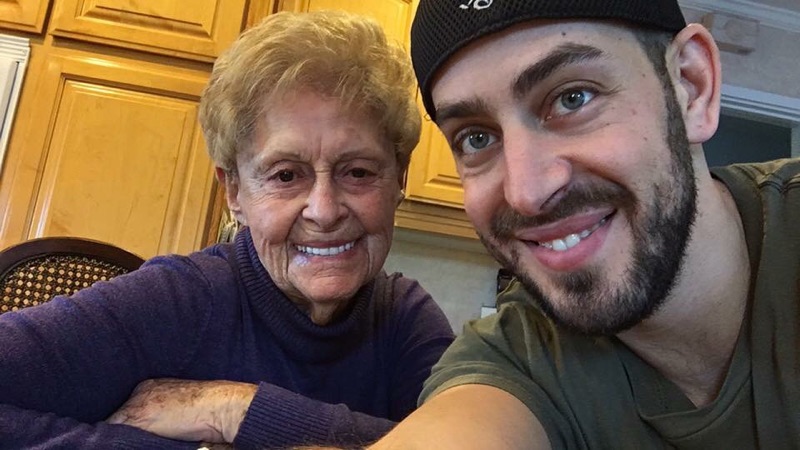
Jul 11, 2019 | aging, aging in place, cost of aging, diminished cognition, elderly, health, resources for senior, resources for seniors, retirement planning
Does The Advisor Have A Role With Aging Clients Who Become Unsafe Living Alone?
Carolyn Rosenblatt, RN, Elder law attorney, AgingParents.com
You’ve known the client for many years. As time passes and she lives longer than she thought she would, you see her inevitable decline. She loses her husband, on whom she depended. She doesn’t want to move to assisted living or anywhere, even if you think it would be best for her. Her vision is dimming and her hearing isn’t good either. She has refused all help even when you reassured her she could easily afford whatever she needs.
Is there anything you can do? You care about the client but you’re used to just managing the money, and it isn’t clear that you are obligated to go beyond that. But you know that your client just isn’t safe alone anymore.
In these situations, the most competent advisors and wealth managers can feel conflicted about their roles. They have over the years come to know the client well and there is a sense of wanting the client to be safe. At the same time, maybe it’s not an advisor’s problem. What about the family? What if there is no family?
The first thing every advisor should do is what the regulators make optional for you: “try” to get a trusted third party contact. From our vantage point at AgingInvestor.com and AgingParents.com, we think it’s ridiculous to consider it an option rather than a requirement to get a trusted contact on file. The advisor can be more trusted than family in some cases and has a unique vantage point. YOU are the one who may be first to see your client’s decline and need for greater safety in the client’s living situation. You need to have someone to call. If it’s family and they are willing to step in, good. If there is no family, the client must be advised to hire a licensed person who is capable of overseeing their care if needed and to assist with day-to-day finances. The term “fiduciary” has a different meaning in the context of your industry, but outside it, a fiduciary can be a person whom the state licenses to manage money for someone who is not able to do it alone. They serve in the capacity similar to that of a conservator, guardian or power of attorney appointee, but the aging person still maintains some control as long as he or she remains cognitively intact. For those with no family a licensed fiduciary can solve the question: who can the client count on to help?
Even when there is family the aging client can still resist moving to a senior’s apartment in a community rather than struggling on living alone. It happened in our own family. It took two years for Dr. Davis’ mother, Alice to make up her mind to give up living alone in a house. To see a short video, Alice’s perspective of her decision. Click HERE.
At age 90, she had vision and hearing problems, arthritis, leg pain, unstable blood pressure, kidney and bladder issues and she took 14 pills a day. That by itself was not enough to get her to agree to move. She ultimately reached the decision because she got tired of the daily difficulty she had trying to maintain independence.
Even with your efforts to persuade a client that he or she ought to consider some new choice like assisted living, remember that a person who is competent can’t be forced to move anywhere. Logic has nothing to do with the fear of losing one’s independence. But keep trying and do work with the client’s family on a joint plan to help your client get to a safe decision.
What Action Can You Take?
Can you tell your client’s family about your observations? We see no ethical dilemma at all here. This is not about financial matters necessarily though it can be. The cost of moving and paying for care is a factor. But no one says you have to talk about what’s in your client’s portfolio. To be in the best position in anticipation of a client who is declining with age, get your client to identify any family or friends who could be called upon “in case of emergency”. Get more than one trusted contact. If you have a few people on the list identified by your client, call a phone meeting and discuss strategy. Gentle persuasion can work over time as it did with 92 year old Alice, who finally decided to move into a senior’s apartment. She was mighty stubborn but it did work out in the end, absent disaster. We were fortunate.
The takeaways from AgingInvestor.com:
Anticipate that long-lived clients may become unsafe living alone. Most people over age 80 need some kind of help in their lives.
You as the trusted advisor can be ready for age-related decline in your clients by having several trusted contacts in your client’s file whom you know and can call upon when safety is an issue.
If you become aware that your client is losing independence and should not be living alone, call a phone meeting with the trusted contacts to develop a strategy for working together to help your client make a good decision about moving or bringing help in.
Expand your role of merely managing the money and use your position of trust to help your client and the family keep the client physically safer.
If this all seems to be an awkward and uncomfortable thing to address, get a consultation from experts on aging at AgingInvestor.com. Our nurse-lawyer, geriatric psychologist team offers you expertise in how to approach a problem with an unsafe client and even what words to use to help them with important safety decisions.

Jun 18, 2019 | aging, aging investor, cost of aging, cost of long term care, declining health, elder investor, elderly, finances for elders, financial advisors, financial judgement, long term care, nursing home, resources for senior, resources for seniors, retirement, retirement planning, senior investor, seniors finances
An Important Question For Your Clients Contemplating Retirement
Longevity is increasing, as millions of Americans are living to 90 years and above, the U.S. Census Bureau reports. Will any of these long-lived folks be the parents of your current clients? Some clients reaching retirement age themselves will be dealing with the challenges of their aging family members, even as they plan their own retirement years.
One critical question perhaps not built into your calculations for retirement income needs should be whether your clients can reasonably expect to have to support their aging parents. As reported by NPR citing the Census Bureau report, nearly 20 percent of 90- to 94-year-olds live in nursing homes. Among those 95-99, about 31 percent are in nursing homes. And in the 100+ population, 38.2 percent live in nursing homes. Who pays for that care?
Most financial advisors have a basic understanding that Medicare benefits are very limited when it comes to nursing home care. Post hospitalization, the maximum benefit is 100 days and most people do not receive even that, due to qualification requirements. For those who have to live in nursing homes long term, rather than for shorter stays involving rehabilitation such as physical therapy, the costs are paid out of pocket. The exception is for the lowest income elders. For them, Medicaid pays the cost of long term nursing home care. For everyone else, a long stay in a nursing home can wipe out an older person’s assets. The financial burden then falls on family who may have the means to prevent the impoverishment of their loved one.
Some adult children will not allow Mom or Dad to live in a nursing home long term. Maybe it was a promise they made to the aging parent. Essentially, it is no one’s first choice of where to go when care is needed. If a family has some assets but does not want to wipe out their own retirement income by paying for nursing home care or even full-time home care, the most cost effective solution is to take in the aging parent.
There is a cost involved in this choice as well, and it extends to many factors beyond money. Every family relationship in the household is impacted. Some adult children are not patient, not willing and not good at caring for an impaired aging parent in declining health. For others it is seen as an honor and a final chance to give back to the parent in gratitude for what the parent did for them over a long lifetime. Individuals vary in their perspectives, ability and willingness to take in an aging loved one.
Some families take in an aging parent and pay for part-time help, providing a significant part of the caregiving themselves. Others pay for assisted living for an aging parent, but that is not suitable for those who need care around the clock. Others allow a parent to spend down their assets until they can qualify for state paid nursing home care. The parent is then placed there somewhat as a last resort.
No matter what choice a client will make about an aging parent, it is important that the financial professional in their lives helps them see the big picture and plan according to anticipated needs for both the client and the elders for whom they feel responsible.
The Takeaways
- Longevity is creating an issue for families who are facing years of decline in aging parents who may not have the means to pay for care on their own.
- Responsible financial advisors must raise the question with every retiring client: is there someone in your life that you will likely have to support financially during your retirement?
- Advisors and families alike must consider and plan for how any essential financial support should be handled by adult children of aging parents. Take in the parent? Supplement the parent’s income by paying for home care or assisted living?
- When the means are not available to offer financial support, and the physical needs for care are extensive, it sometimes becomes necessary to allow the aging parent to become impoverished and to qualify for Medicaid. Medicaid does pay for long term nursing home care.
- For those with sufficient investment income expected, financial support for aging parents can be part of an overall retirement planning strategy. It is up to the financial professional to help with this process.
Carolyn L. Rosenblatt, RN, Attorney, AgingInvestor.com ©AgingInvestor.com™
If you the financial professional need a clear explanation of the actual costs of long term care, whether at home, in adult day centers, assisted living or skilled nursing, get the facts so you can plan with clients. It’s all laid out for you in Hidden Truths About Retirement & Long Term Care, available now. Click here to get your print, digital, or audio copy.
About Carolyn Rosenblatt and Dr. Mikol Davis
Carolyn Rosenblatt and Dr. Mikol Davis are co-authors of The Family Guide to Aging Parents (www.agingparents.com) and Succeed With Senior Clients: A Financial Advisors Guide To Best Practices. Rosenblatt, a registered nurse and elder law attorney, has more than 45 years combined experience in her professions. She has been quoted in the New York Times, Wall Street Journal, Money magazine and many other publications. Davis, a clinical psychologist and gerontologist, has more than 44 years experience as a mental health provider. In addition to serving his patients, Davis creates online courses and products to assist professionals and the public with understanding aging issues. Rosenblatt and Davis have been married for 34 years.

May 9, 2019 | aging, aging investor, cost of aging, declining health, diminished cognition, elder investor, elderly, finances for elders, financial advisors, financial capacity, financial elder abuse, financial judgement, handling money for aging parents, handling money for seniors, resources for senior, resources for seniors, scammers, senior citizen investor, senior investor, seniors finances
The Senior Safe Act allows you to hold transactions when you suspect financial abuse of a client. The Act is designed, at least in theory, to allow time for the trusted contacts you have on file to take appropriate action. Many of those victimized by predators or manipulated by unscrupulous family have dementia and have lost their judgment about what makes sense financially. The Act urges you to get trusted contacts and provides that you are not breaking privacy rules to contact them in the reasonable belief that your client is being financially abused. The length of time you can hold a requested transaction can be as long as a month. This is where the Senior Safe Act has missed the mark.
Let’s look at the reality of impaired elders who are in charge of their wealth on the family trust. The trust is in order, and if the elder recognizes that he or she is experiencing decline in mental ability, that trustee may choose to resign. Simple. But that is not what happens in too many cases. For many persons who have cognitive decline and dementia, the elder does not recognize that he is impaired at all. “I feel fine!” he tells his worried family. When asked to resign as trustee, having total control over (theoretically) millions of dollars in a trust, the elder flatly and stubbornly refuses. Meanwhile, financial abuse by predatory people can continue unabated.
When an older person experiences cognitive decline, it typically has a very slow onset. Short-term memory loss does not raise enough red flags for those closest to the elder to take any action. “She’s just getting old” they say dismissively. But memory loss is often the first and earliest warning sign of Alzheimer’s disease, the most common form of dementia. The odds of having Alzheimer’s disease by age 85 are at least one in three. Think about your own older clients. Some live well beyond age 85. The risk of dementia rises with age. Short-term memory loss interfering with daily life is not a normal part of aging. Financial abuse and cognitive impairment often go together.
When financial abuse reaches a visible level, the advisor may do what the law allows and call the trusted contact person, usually an adult child. The advisor hopes that the call will somehow trigger something and the abuse will be stopped. But here is a reality check: The family can’t accomplish anything needed in two weeks or even a month if you hold transactions then. Here is a real case example of just such a situation, showing how long it really did take.
In our work with a family at AgingParents.com we saw rampant financial abuse of an elder by a family member. The elder had dementia but had not been formally diagnosed by his doctor. Over 70% of his income was going to the predator. He was asked to resign as trustee by his two adult children, who were reasonably worried that he was going to give away all his cash and further encumber his home. The dad, whom we’ll call Gene, had been developing dementia for at least two years. He felt obligated to the predator and was totally powerless in resisting her demands for money. He just kept writing checks, draining his own resources. It was clearly a case of financial manipulation.
We were involved in working to persuade Gene to allow what his family trust provided: to have his daughter, Jennie, become the successor trustee. He agreed, then reneged. He accepted the logic and then refused to accept it. The kids had no choice but to use the law to take over control. Their father was too stubborn to resign as trustee when asked, even with the entire family presenting a united front, asking and respectfully begging.
The trust, like many such documents provided that Gene could be removed as trustee by his appointed successor, his daughter, after two physicians had declared him to be incapacitated for handling his own finances. A court decision was not required. However, getting him to two doctors willing to assess him and put their observations in writing was a challenge that took months to accomplish. The total time spent getting the change of trustees accomplished according to the terms of Gene’s trust was eight months.
His children were the trusted contacts in the advisor’s file. They knew about the abuse and were in agreement with the advisor that Gene had to stop being the trustee. The adult children had to hire consultants (AgingParents.com), have meetings, hire an attorney, and try various methods to get the job done. Their time energy and thousands of dollars were expended to prevent an even worse outcome, which was being left to support their aging father if he were to totally deplete his own funds.
The takeaways:
- Though well intended, we do not expect that the Senior Safe Act will do much to stop financial abuse because of the short time allowed for a financial professional to hold transactions. In Gene’s case, the predator would have been happy to wait a mere two weeks or a month before resuming the financial manipulation of Gene.
- Know that any older impaired client may not understand that he or she is cognitively impaired and will ignore pleas to resign as trustee with total control over any family trust.
- If you see that an older client is showing signs of cognitive decline, do not wait until it gets worse. Reach out at the time of your first suspicions of trouble. The family or other trusted persons may well have a better opportunity to persuade an elder to transfer power over finances to the appointed successor before complete loss of capacity. Expect this to take time.
In the case described above as a result of ongoing financial abuse, nearly all of Gene’s cash was depleted during the eight months of effort on the part of his adult children to have him removed. The advisor did the right thing but too much of Gene’s cash was depleted in the period when the abuser could keep manipulating him for those months of effort by family to have him removed as trustee.
By Carolyn L. Rosenblatt, RN, Elder law attorney, AgingInvestor.com
If you are seeing abuse and feel lost about how to stop it, contact us at AgingInvestor.com for a confidential consultation with our nurse-lawyer, geriatric psychologist team so you can do everything possible to protect your vulnerable client.

May 6, 2019 | aging, aging investor, elder investor, elderly, finances for elders, financial advisors, investor, resources for senior, resources for seniors, retirement planning, senior investor, seniors finances
Retirement For Clients With Modest Portfolios—Making Money Last
By Carolyn Rosenblatt, RN, Attorney, AgingParents.com
The U.S. Census Bureau projects that by 2060, nearly twenty-five percent of Americans will be age 65 and above. At the same point, the number of people age 85 and older will triple. What will they all be doing in those long retirement years? If they live into their 90s, will they run out of money?
Many who have not saved enough ultimately find new jobs. Working in retirement is something to discuss with clients who are aging, have set a retirement date and have no answers to what happens if they outlive their savings. The advisor is not a miracle worker who can stretch their dollars beyond what is reasonable with prudent investments.
Maybe some clients will consider seeking a “not too big” job that is relatively easy, compared with what they did in a prior career. For the advisor with a client whose invested assets have a predictable length that does not match life expectancy, it is wise to help them plan how to keep their dignity as they live longer than they thought possible. That is through producing some earned income, even if modest.
If an older client is determined to retire from a stressful job, that’s fine. No one needs high pressure forever. But every job is not stress filled and some are more satisfying than others. The stereotypical image of a retired elder serving fast food is not for everyone, especially for educated clients who may have more interesting choices. For some retirees, long stretches without structure lead to isolation, boredom and even to depression. The routine of some kind of work relieves that risk and can bring enjoyment a person never had in the prior career.
Some may need the double benefit of bringing in money while finding ways to be with others. Elders certainly don’t need to go from one job to another at the point of retirement, but the holistic retirement plan for a person with modest investments should include some form of earning money through work. Your client may expect that family is willing and able to provide financial support if the client runs out of money. This prospect does not appeal to many younger families who are still supporting their own children and saving for their own retirement. They fear the idea of having to support aging parents and rightly so.
Imagine a client finding something to do in retirement that pays and something the client likes. Here’s an example.
My 30-something daughter is a regular Uber user who likes to converse with her drivers in San Francisco. She reports that three of her drivers in past two weeks were over age 65. One was age 80. He told her that he had retired from a union job at age 65. His wife had passed away and he got withdrawn and bored, having no sense of purpose. He worked part-time as a warehouse floor worker and cashier. He liked the walking and being around people. He worked another few days a week driving which he enjoyed because it kept him sharp, using the app, navigating around the city, keeping track of the best ways to get places, and most importantly, he liked chatting with his passengers.
Longevity creates a pool of older workers available either part-time or full-time, not necessarily expecting a benefits package and having no lofty career aspirations. Employers in a broad variety of service fields can benefit, as can the potential workers. We have met elders at AgingParents.com who have gotten a teaching credential after retiring from a high pressure career and are happily teaching part-time. We have found others who are mentoring in businesses, working in nonprofits, doing childcare, working in retail and otherwise using their natural talents while earning a paycheck. These were all part-time positions and all were glad to be doing them.
Discussing the possibility of working with your older clients should include when in retirement the client should consider doing it. Physical and mental loss of ability can preclude work of any kind, even volunteering. They can’t necessarily count on being able to work in the later years of retirement when they may run low on cash. Someone might be fine at 70 and impaired at 85. The time for planning an appealing part time job is in the earlier stages of retirement when the client is feeling good and is not impaired by health problems.
If your client has a modest portfolio that with a conservative drawdown would only last 20 years and life expectancy is 30 years, you need to encourage working. Take the axiom “know your client” to a realistic individual plan for living long with sufficient means.
If you have trouble with these sometimes emotional, difficult conversations, contact us at AgingInvestor.com for a private one-on-one consultation so you can get the job done. Click HERE to find out more how we can help you.

Apr 25, 2019 | aging, aging investor, elder investor, elderly, financial advisors, financial judgement, handling money for seniors, senior investor
As an advisor, you hope that your clients trust you and will stay on with you for life. You may be doing well in managing their finances. You may never hear any complaints about your fees. But unseen forces can be at work and any one of them can prompt your client to think he or she needs to go somewhere else. Lures of lower fees, better returns or a younger family member urging them to give up your management can undermine the trust you thought you had. How do you maintain the relationship? What can you do besides your essential job of skilled management to keep clients?
Consider that everyone appreciates being thought of and attended to one way or another. If you look at marketing efforts from another industry, real estate, you note that brokers and agents send lots of mailings and notices to prospects over time, just in hope of keeping themselves, top of mind. They may not even know you but they send mailings to your address or email anyway. If they do know you, you may even read what you receive. It makes sense to find reasons to contact clients regularly even if there is no need to update them on the performance of their portfolios. One way is to send them something as a courtesy, to let them know you want to be helpful.
You may know that financial abuse of elders is a massive problem in our country. In fact, research shows that it costs elders over $36B a year. Most aging clients have heard of abuse or scams, but may think warnings would not apply to them. But of course no one is immune. At AgingInvestor.com, where we focus on advisor education and training about age-related issues, we urge every advisor to keep retirement-age clients informed of scams and fraud. There are two important reasons for this. First, you may actually prevent a client from getting ripped off by educating them. And second, sending regularly scheduled communications about these issues and more can strengthen your relationship with the client.
If you don’t have time to write or look up what to send clients, we make it easy for you. Go to AgingInvestor.com and get started. Send your clients the AARP tip sheet on avoiding scams you’ll find HERE. They can learn about common scams and what to watch for. We even created a brief suggested cover letter or email you can send with it. You can use this one or create a letter that works for you. We have a series of free things we assembled so you can use them to maintain the best, warmest communication with your aging clients. It will deepen your client relationship and they’ll appreciate you even more!
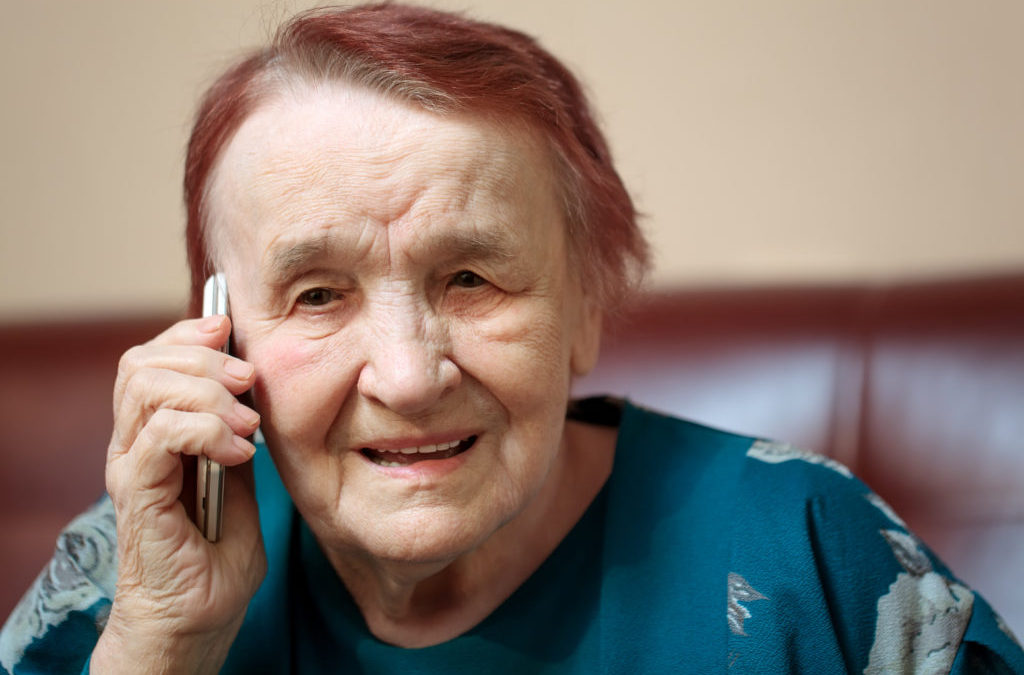
Apr 25, 2019 | aging, aging investor, declining health, diminished cognition, elder investor, elderly, finances for elders, financial advisors, financial capacity, financial judgement, handling money for seniors, health, senior investor, seniors finances
Clients Without Family: Financial Planning With “Elder Orphans”
Every financial advisor will eventually come across an aging client who is essentially alone in the world. The elder may be single, widowed, or otherwise without a partner. Some are members of the LGBTQ community and never had children. Others were childless, or have lost children and significant others in their long lifetimes. The end result is that the usual support systems that exist for others are not available to these clients when they may need support the most.
Some refer to these elders who are alone with no family as “elder orphans”.
Heidi is an example. She has a financial advisor who has worked with her over decades. He referred her for advice, which she wanted and I visited her at home. She is 90 and lives alone in her own house, which she owns outright. She has a modest portfolio and is comfortable. She was widowed 20 years ago and she has no children, nor any relatives in the U.S. She relies on her best friend and neighbor when she needs help. This need is increasing now that her vision is impaired. When I spoke with Heidi I asked her about her one best friend. She mentioned that this neighbor is 86, but is “doing pretty well”. Heidi had recently fallen twice in her home, but fortunately escaped serious injury from those falls.
Heidi has a will and a trust, power of attorney and healthcare directive. The appointed person on those documents is her cousin who lives in another country. If an emergency occurs, it is not at all clear who would be available to assist her.
This situation is a disaster waiting to happen. The risk of another fall, vision problems that will likely prevent her from driving, and the age-related risks to her friend the 86 year old who could also become disabled or unavailable are all looming. I ask if her financial advisor has discussed the future with her, possible other living arrangements, a local person for a healthcare agent and what to do when she can no longer drive. “No” she replies, “we’ve never gotten into that”.
I urged Heidi to contact her financial advisor right away so plans could be made and her safety assured. She also needed to speak with her estate planning attorney to update her documents, ensuring that an appointed local person had authority to assist in any crisis or if Heidi loses independence. She is close to needing help now.
Think about your book of business and whether you have any “elder orphans” in it. If so, there are things any responsible advisor should address with such clients. Here are three essentials for every advisor’s discussion.
- First, the legal documents. The advisor can get permission from the client to contact the estate planning attorney and find out what plans exist for an appointed person to step in and take over the reins when or if the client becomes impaired. a local appointee is critical. Someone has to be able to make financial decisions if the client loses the ability to make them independently.
- Next, alternative living arrangements. A 90 year old with impaired vision who has fallen at home may need to consider options of where to live with help available onsite. The financial advisor knows what assets are available to pay for a choice such as assisted living. The advisor should bring this up and ask the client about what he or she wants.
- The need for a local appointed person to be not only the advisor’s trusted contact, but your client’s person to reach in the event of an emergency. An appointee in another country is not going to be of immediate help. Explore other choices.
The advisor needs to expand the limits of the usual role of simply managing the money with elder clients who do not have any family. To keep you on track and aware of the special planning these aging investors need, get your free checklist of points to address at AgingInvestor.com. With it, you can be sure of what you need to cover in your planning conversations with you “elder orphan” clients. Download Your Advisor’s Seven Point Checklist— Best Planning For Aging Clients With No Family now so you can excel in appropriate future planning.
Carolyn Rosenblatt, RN, Attorney, AgingInvestor.com

Apr 10, 2019 | aging, finances for elders, financial advisors, financial capacity, financial elder abuse, financial judgement, handling money for seniors, investment news, scammers, senior citizen investor, senior investor, seniors finances
Warn Your Aging Clients About A New Telephone Scam–Fake “Social Security” Calls
Carolyn L. Rosenblatt, RN, Elder law attorney, AgingInvestor.com
Scammers targeting your aging clients are getting smarter about how to fool them. Thieves can use spoofing computer software to trick the recipient of a call by showing a “real” number on caller ID. Pretend caller ID isn’t new but using it to target seniors on Social Security is a cruel tactic used to intimidate seniors. Here’s how it works. The evil caller has your older client’s telephone number and knows him to be at least of Social Security age. When the call comes in, it shows on the ID that yes, it’s Social Security. The caller immediately tells the elder in an authoritative voice that her Social Security number has been blocked. Of course this draws the expected reaction from most people–fear. They are not going to question what it means to have the SS number “blocked” or if that is even possible. (It isn’t.)
The caller says it is urgent and that in order to “reactivate” the SS number, the elder must act immediately, or their Social Security benefits will be affected. As your senior clients had paid into Social Security since its inception they don’t want to lose it. The scammer convincingly fakes concern and wants to “help”. All your aging client has to do is pay a fee and the number will be unblocked, they’re told. Many elders have heard of identity theft and believe that this person is going to help them prevent unauthorized use of their SS number, because that is what they hear on the call. Of course the caller then needs to “verify” the number and your client complies and recites the number. Instantly the number can be put into use any number of ways identify thieves have devised. And worse yet the elder pays them the “fee”.
Even if you believe with all your heart that YOUR aging loved is not dumb one and won’t fall for any of this, do not be so sure. Anyone can be caught off guard. Scammers are very clever at using fear and other strong emotions to manipulate unsuspecting aging parents to give up information without thinking about whether the request for it makes sense. You want to warn them. You want to remind them that they are never to give out any personal information like a SS number to a person they did not call themselves. Everyone’s Social Security numbers are potentially floating around in cyberspace enough as it is, without handing them to a telephone stranger who is lying to get them to pay money. You can warn your aging parents that the Social Security Administration will never ever call and ask anyone to verify the SS number. You can remind them that even if the caller ID shows something that looks real, it can be fake because spoofing software can show anything the scammers want it to show.
Millions of elders are approached regularly by this telephone scam and many others. My own mother in law, now passed, was very smart at fending off such phony calls and smelling a scam. But by age 95, that scam sensor she used to have seemed to fade. One day a man called her landline and said he was from Medicare. He just wanted to “confirm her Medicare number”. She had an active Medicare claim going on at the time, and we were helping her address the details. Because she had that claim, she fell for the trick. She gave the caller her full name, address, date of birth, mother’s maiden name, and her Social Security number. Fortunately we found out within a day and were able to jump into action to change all her accounts and credit cards. It took four months to straighten out the mess. The scammers got nothing. We got a lot of work, and had to take her to her banks and financial institutions in person to change everything. She felt bad because she was supposed to know better. Yes, but she forgot. We were lucky to find out before anything worse happened.
The takeaway here is that financial advisors are in a unique position of trust with your clients and they are likely to read a friendly letter from you, just giving them a heads-up about the latest scam. We urge you to create an old fashioned series of letters warning them about scams, about things happening in your industry that affect them, such as the Senior Safe Act and just staying in contact. When they hear from you in a friendly way, it reminds them of why they like and trust you. You’re more likely to retain them that way.
No time to write? Let us help at Aging Investor.com. We have free, pre-made client education material created just for seniors. You can simply download and send them out at intervals to all your retirement-aged clients. To access these items, ebooks and checklist, go to the Books and EBooks menu on our home page and find Resources for Clients. It can only make you look good to your investors!
|
|
Dr. Mikol Davis and Carolyn Rosenblatt, co-founders of AgingInvestor.com
Carolyn Rosenblatt, RN, Elder Law Attorney offers a wealth of experience with aging to help you create tools so you can skillfully manage your aging clients. You will understand your rights and theirs so you can stay safe and keep them safe too.
Dr. Mikol Davis, Psychologist, Gerontologist offers in depth of knowledge about diminished financial capacity in older adults to help you strategize best practices so you can protect your vulnerable aging clients.
They are the authors of "Succeed With Senior Clients: A Financial Advisors Guide To Best Practice," and "Hidden Truths About Retirement And Long Term Care," available at AgingInvestor.com offers accredited cutting edge on-line continuing education courses for financial professionals wanting to expand their expertise in best practices for their aging clients. To learn more about our courses click HERE
|

Feb 21, 2019 | aging, aging investor, cost of aging, cost of long term care, declining health, elderly, finances for elders, financial advisors, handling money for aging parents, handling money for seniors, health, long term care insurance, resources for senior, resources for seniors, retirement planning, senior citizen investor, senior investor, seniors finances
It used to be that we could think of retirement in a kind of predictable way. People lived into their 70s perhaps, and we measured retirement by that. We used tables, algorithms and other tools to tell us how much we should save and how much we could spend in retirement. And it was all based on assumptions that may no longer apply.
Life expectancy for a woman in the U.S. in 2018 was 84 years. For a man, the figure is 80 years. Those averages do not take into account the fact that well educated and financially secure people live longer than average. This is presumably based on the notion that people who know what a healthy lifestyle is and who can afford the best medical care will outlive those who do not have those advantages. In my own county, for example, which has a high proportion of elders compared to other counties in California, one wealthy city shows a life expectancy for men of 93 years.
Suppose that your aging client lives to be 93, having retired at age 65. That’s 28 years of retirement. What the algorithms don’t clarify is what you, the advisor needs to plan for with your client during the last decade of life, from 83-93. No formula is going to help you with the individual discriminations you need to make concerning your client’s risks for care and how to assess and plan for them. They can be a substantial cost, out of pocket, not covered by Medicare, and absolutely necessary.
The way we age is determined by two main factors: hereditary tendency and lifestyle. Our genetic makeup directs only about 30% of the equation. The other 70% is driven by the way we choose to live our lives. There are plenty of folks who think that a healthy lifestyle is just too much bother. They avoid exercise, eat whatever they feel like eating, never learn to manage stress and say they’d rather die a few years sooner than give up their habits, which their doctor advises against.
Here’s the problem with that belief. Leading an unhealthy lifestyle does not just cause you to “die sooner”. Rather, it may likely cause you to live with impairments, disabilities and a need for expensive long term care for chronic health conditions. These can go on for decades.
Take obesity, for example. Over two-thirds of Americans are overweight or obese. Obviously excess weight increases our risks for all manner of health issues, including diabetes, heart disease, high blood pressure, and strokes. When a doctor makes a diagnosis of one of these, the person doesn’t typically just die on the spot and save a lot of expense later on. No. The medical providers will keep the person going with medications, surgery in some cases, lots of diagnostic monitoring and trips to the doctors. These chronic conditions usually lead to disability late in life, particularly when more than one of them exists in the same person.
If you have aging clients, you definitely need to understand health risks in a basic way, so that you can help your clients set aside funds for the care they are likely to need in the last years of their retirement lives. All of the chronic conditions I mentioned are manageable with an effort toward a healthy lifestyle but for those who do not wish to do the work involved, you can bet on a likely need for long term care. While you can’t predict the future, you can plan for risk. It’s what you do.
My own mother in law had high blood pressure and chronic kidney disease for decades. She worked vigorously at diet, exercise, social activities and other components of a healthy lifestyle. Heredity was not on her side. She lived to be 96. During the last 3 years of her life, she needed help. She moved to a seniors’ community where help was available and eventually, she paid for private caregivers. Her cost of living at the last part of her life was $120,000 a year. If this were your client, would he or she have at the ready $360,000 to pay for care? How about if there was no pursuit of a great lifestyle? The care expense could easily be 10 years.
The takeaway here is that advising for longevity needs to include the skill of assessing fundamental health risks that create a need for out of pocket, long term care. You don’t need to be a doctor and you can’t predict everything, but you can do what is reasonable to help your client plan. Ask the right questions. Keep track of your client’s general health picture.
To learn more about what to look for and what to ask, get Hidden Truths About Retirement & Long Term Care, available at AgingInvestor.com and on Amazon.
By Carolyn L. Rosenblatt, RN, Elder law attorney, AgingInvestor.com
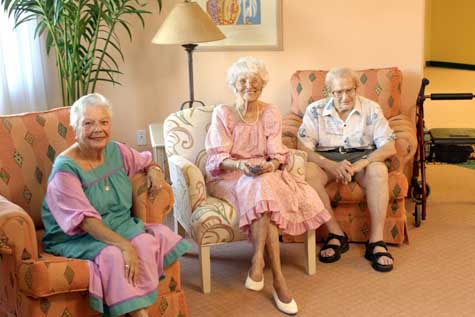
Feb 5, 2019 | aging, cost of aging, cost of long term care, custodial care, declining health, elderly, finances for elders, financial advisors, handling money for aging parents, handling money for seniors, health, long term care, nursing home, resources for senior, resources for seniors, retirement planning, seniors finances
The financial services industry often refers to retirement planning for the future with aging clients in terms of “housing choices”. This reflects some degree of misperception about what happens as we age. For healthy people of retirement age, there is little interest in planning for the need for care and planning for loss of independence. People usually resist talking about it. We don’t choose to lose our independence. It happens. It is up to the advisor to raise it if you want to advise for longevity. The subject is emotional and can be difficult.
Where we need to get help when we can’t be independent any longer is really a choice about care, rather than housing. This is not house shopping. Does a client want to pay for care in her own home when that time comes? Most would say yes, they want to remain at home. They then must calculate what a home care worker costs and whether that is the best way to receive the help they are likely to need one day with their activities. Can the resources be available to enable that choice of where care will be given?
If an elderly client is living alone and can’t manage at home anymore without assistance, there are indeed choices, often driven by the degree of care needed and the cost of getting it. Elders may not be interested any longer in maintaining a house, cooking, shopping, and other necessary chores. For them, assisted living may be desirable because their daily lives will be different and free from the burden of the household that has become unmanageable. The choice to go to assisted living is usually not one a client is going to make because of wanting to downsize into an apartment for its own sake. Rather that is the price of going to the place where assistance is on hand. Again it is to receive care, not because they love the idea of not having their home any longer. For many elders, downsizing from a house to an assisted living apartment is a difficult adjustment, required because of physical or mental changes of aging. From that perspective it is a choice forced upon them.
A factor every advisor should know is that the likelihood of living alone increases with age. Almost half of women age 75+ lived alone in 2010, according to the Institute on Aging. The “choice” of a different living arrangement is brought on by safety and care concerns, often raised by their adult children.
It will be good for every advisor who wants to help clients plan for longevity to consider that their role is to introduce the issue of possibly needing care in the future, as about 70% of us will one day. If your client has you in her life, she already has housing. Planning for “housing” is a misnomer. Focus on places and choices where care can be delivered. Having no care plan can be disastrous, as sudden health crises can force decisions without considering the cost of care in advance.
In helping to educate your client about where he or she can receive care, the costs of all the offerings available in most areas are spelled out in detail in our book, Hidden Truths About Retirement & Long Term Care. You can develop quick expertise on the subject there. Skilled advice about longevity for your aging clients requires knowing your numbers, what care options are available where they live and how much they can expect to spend for that care. Smart advisors gather the data before a crisis happens and urge clients to look at it with them.
By Carolyn L. Rosenblatt, RN, Elder law attorney, AgingInvestor.com
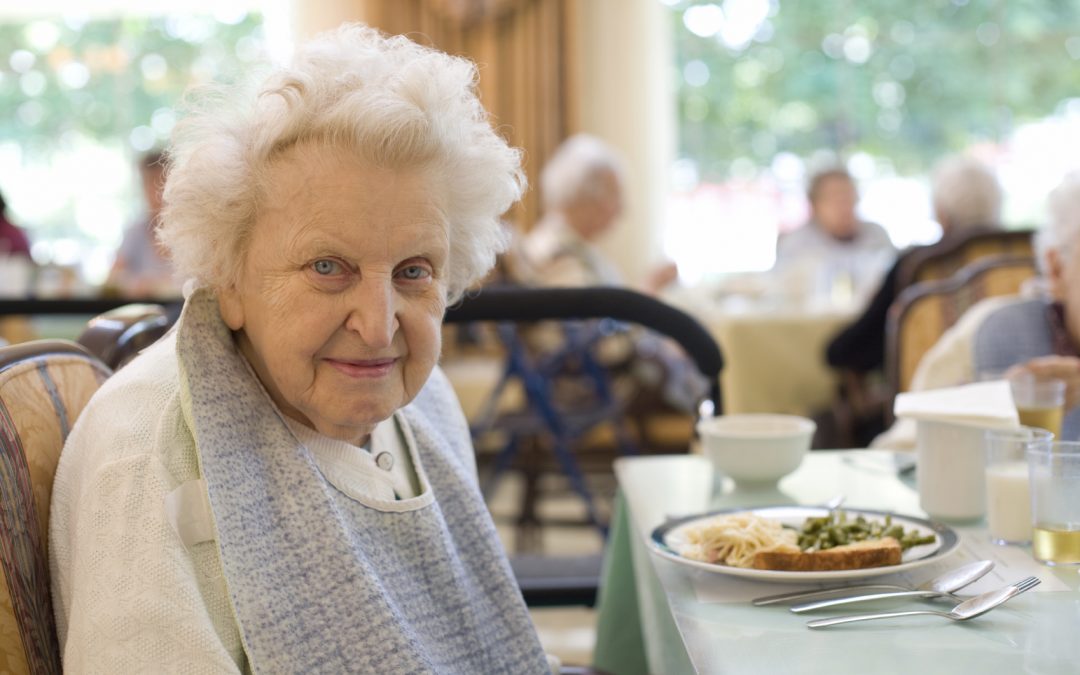
Jan 30, 2019 | aging, aging in place, cost of aging, cost of long term care, declining health, diminished cognition, elderly, finances for elders, financial advisors, financial capacity, handling money for seniors, long term care, nursing home
Most advisors who even ask this question of their retirement-aged clients never spend time on it. About 90% of those asked say they want to remain in their own homes as long as possible. That sounds fine. Until one faces physical decline, cognitive impairment or both. The advisor providing competent guidance about financing aging at home had better know the facts.
None of us like to think about losing physical ability or needing help. We abhor the thought of losing our total independence. In our view at AgingInvestor.com, the only advice clients are getting is about the long term picture is whether or not to purchase long term care insurance. Since most people don’t do that, the actual costs of living at home can boggle the mind. It’s the best advisor’s obligation to educate your client about the risks of the plan to age in place, just as it is your obligation to educate them about balancing their portfolios. You are giving the client added value if you take the time to talk them through the risks and dollars they may need to have available.
Here are some briefly stated facts from a real case in which an 89 year old wanted to age in place and his wife promised he would never have to leave home.
At the outset of his declining health, he had about $3M in invested assets. His portfolio was healthy and balanced for his age, according to conventional wisdom. He began to lose his ability to walk due to multiple medical problems. His wife hired home helpers, three days a week at first. As his conditions progressed he needed more and more help. He had to have a wheelchair, and a special van. A stair chair was installed in their two-story home. By the time he reached age 95, he was spending over $150,000 a year on care and assistance around the clock. In the space of time during which he was steadily losing independence until he passed away at 95, his assets were depleted to the tune of $2M. He lived in a higher end market for the needed help but the reality is that in any market, the kind of care he needed would be very expensive.
For him, aging in place was more costly than a skilled nursing facility would have been. Home modifications, private caregivers, (none of whom were licensed nurses), equipment, medications, adaptive devices, etc. drained his resources by 2/3. And not everyone has as much invested as he had to even start the journey. His wife had her own assets and she paid the cost of household maintenance, taxes, food, and utilities with her funds. Had she relied on him for those things too, there would likely have been little left at the end of his life.
It is not all doom and gloom however. Many clients live rather well in their last years without all the care this gentleman needed. Some get by with family caregiving help, and some have fewer medical conditions. But if you are going to competently help your clients plan for longevity, it’s essential to understand the real out of pocket costs of aging in place or anywhere else outside the home. If you want to add value to your services to older clients, know what they need to know to properly anticipate what can happen with living into one’s 90s and beyond.
Learn all the actual costs of care for every aging client option in our book, Hidden Truths About Retirement & Long Term Care. Be well prepared to walk your client through the scenarios they could face in their futures. You distinguish yourself from other advisors when you sharpen your knowledge in planning for longevity.
By Carolyn Rosenblatt, RN, Attorney, AgingInvestor.com

Jan 28, 2019 | aging, aging in place, aging investor, cost of aging, cost of long term care, custodial care, declining health, diminished cognition, elder investor, elderly, finances for elders, financial advisors, financial capacity, financial elder abuse, financial judgement, handling money for seniors, health, long term care, nursing home, resources for seniors, seniors finances
Your clients are getting ready for retirement. You’ve done the calculations, balanced the portfolio and advised them of what income to expect. You’ve discussed how much spending is ok. You used your program and your analysis was thorough. You’ve done your job, right?
Not exactly. There is probably no algorithm nor program that will calculate your client’s individual profile of health risks that will likely lead to the expense of long term care. That can be a whopper. Maybe you’ve suggested long term care insurance. Most people don’t choose to buy it. For those who do, the benefits are limited and the “elimination period” (deductible) is thousands of dollars. There go your careful calculations. At least 90% of folks don’t have that coverage. Now what?
But how can you predict what’s going to happen to anyone’s health in retirement, you ask. You can’t be precise, but you surely can make some rational observations and give advice accordingly. Those observations consist of two parts: what you can see with your own eyes and what you can glean by asking a few basic questions. If you think asking any client about their health conditions is too nosy or not your job, consider that if the client needs long term care and runs out of money because of it, they’re not going to think much of you. And the cost can wipe out their security.
Asking about health issues is not nosy at all. Rather, it’s what any smart advisor planning for longevity must do. Let’s not keep pretending that everyone stays the same physically and mentally from the start of retirement to end of life. Our bodies go through wear and tear and things break down. Cognitive decline affects at least a third of people who reach the age of 85. The risk of Alzheimer’s disease keeps climbing after that. Now, what was that life expectancy you were using in your calculation? Was it age 99?
Let’s start with what you can see in your client with your own eyes. (If they’re not in front of you, perhaps Skype is an option). Is your client obese, as about 40% of the U.S. population is? This leads to heart disease, stroke, and diabetes, among other diseases and conditions. The medical care people receive in many cases will save them from dying but they then live with disabilities. And yes, they will be very likely to need expensive long term care. Neither health insurance nor Medicare will cover long term care. Such help as a part time caregiver at home is how most folks start out with long term care. Your client pays out of pocket most of the time. Did you calculate how much it costs as well as how long they will likely need it? If they have multiple medical conditions, and have started long term care, they’ll probably continue to need some form of it for all their remaining years.
Find out what you may not know from simply observing your client’s appearance by asking questions. You can make your own list or get a health care provider to help you with a few targeted questions. You will need to educate your client as to the reason why you need this information. It’s to help them plan for how much to save in their retirement years.
Here are some examples of basic questions that can help you predict the need for possible long term care:
- How’s your health these days? Has a doctor told you that you have any long term conditions?
- Are you taking medications? What are they for?
- Do you smoke?
- Are you concerned at all about any health issues you have at this time?
Do you recall your parents’ ages when they died?Your aging clients will not be eager to talk about the potential need for long term care. When you told them about what to expect for “out of pocket medical costs in retirement”, you did not give them a figure that included long term care. Long term care is not “medical” according to Medicare. Rather, it is called “custodial care”. The client probably will not bring it up, so you must do this.
When you have done your observations and gotten answers to your health-risk related questions at least there is a place to start a meaningful conversation. You can give them figures as to the cost of typical kinds of care, such as a non-medical home care worker. We at AgingInvestor.com recommend starting your projections at age 80 as to when a person might need physical help. Many of us know someone who did require help with at least some part of his or her life at that age. Then you can talk about how any condition your client identifies for you, such as high blood pressure, diabetes, etc. as shortening normal life expectancy and increasing the risk for needing help. If your client already has difficulty with some normal daily activity such as walking or bathing, they are definitely at high risk for needing paid help sooner than a person without these problems.
Clients may be completely unaware of such things as the hourly cost of a home care worker, what assisted living costs each month and what home modifications cost if they are able to remain in their own home. You can find a thorough discussion of these and many other parts of long term care in our book, Hidden Truths About Retirement & Long Term Care, written specifically for financial advisors like you.
Every conscientious advisor needs to wake up to the reality that your retirement income calculator omits the reality check of health problems. We’re not talking about nursing homes, but every other kind of care and help most people will need as they age. If you do want to help clients who are reaching retirement age to plan realistically, include the health risks you can see or learn about by asking.
By Carolyn L. Rosenblatt, RN, Elder law attorney, AgingInvestor.com

Jan 27, 2019 | aging, aging investor, financial advisors, financial capacity, financial elder abuse, financial judgement, handling money for aging parents, handling money for seniors, seniors finances
Scams, theft and fraud with seniors’ money is a growing problem. Now the Wall Street Journal reports that banks in our country calculated a 12% increase in financial elder abuse just in the last year. Why do the thieves pick on grandma or grandpa so much? It looks so ugly to take advantage of an elder.
Your aging clients, whether getting advice or investing in your institution, are targets without a doubt. They hold a disproportionate amount of our country’s wealth. And you can help stop them from being victimized. Over $36B a year is stolen from elders in the U.S. alone.
Your aging parents are easy targets for scammerThe Ss for lots of reasons. Elders in this country hold a disproportionately high level of wealth compared to younger people. Some have accumulated significant assets and they may not see themselves as vulnerable at all. Clearly, diminishing cognition makes it easy for thieves and manipulators. Cognitive decline affects at least a third of people over age 85. Your aging client may not have the awareness any longer to spot a fishy-sounding line from anyone. Widowed clients live alone and are isolated, ready to engage with that friendly sounding, cheerful voice from the clever scammer on the phone.
Thieves stay in contact and weave a trap over time. Many aging folks are dependent on others for care, for help at home and for social contact. Dependency makes them vulnerable. Unscrupulous family members lead the pack of those who seize on that vulnerability and trust to rip off their elders. It’s all too easy to influence an aging person to give a “loan”, access to an account, or power of attorney to a person with ulterior motives, which essentially creates a license to steal. Eventually they all want your elderly client to give them money. That’s where your awareness can thwart them.
Banks are making efforts step up their reporting of suspected elder abuse, but that is not enough to thwart the crime. The Senior Safe Act gives you, the financial professional protection if you report suspected financial abuse. Great. But how about stepping up your contact and review of transactions with any elderly client before abuse happens? Too often, the customer-facing bank employee does not see anything wrong until far too much money has been drained from the elder’s account. After the abuse has occurred, it is too late to get the money back. And there is hesitation at the banks, even when they are warned. To put bluntly, banks can add to the problem.
One example of this involved a client of ours at AgingParents.com where we consult with families and elders. She was the daughter of an 87 year old dad who had some memory problems and was frail, losing independence. Her father was a wealthy man, in a long-term relationship with a younger woman. She had manipulated him into giving her access to his family’s trust account into which his significant income was deposited each month.
The man’s daughter found out after a suspicious withdrawal from the account and she contacted the bank immediately. She traveled to her father’s state, went to the bank in person and showed them the trust, which did not have the girlfriend’s name on it anywhere. She asked them to stop the access by the girlfriend. The bank complied and put the funds into an account to which the girlfriend did not have access. After the man’s daughter left the state, the girlfriend took the elder back to the bank and told him to say that he wanted her on the account. Presto! The bank complied and the girlfriend then had access once again, only one day later. The bank aided the girlfriend in financial abuse of their own elderly customer, despite a specific request to stop it and evidence of manipulation. The matter ended up in litigation. We can only say “how ridiculous!” The financial professional, bank employee or manager should have known better. The picture was classic: warning had been given, paperwork proving the problem was given to the bank, and the bank agreed to take the pushy girlfriend off the account. Then they turned around the next day and did the opposite, just because the elderly customer was standing there. Never mind that he was manipulated into saying what the woman told him to say, prodding him as he stood there. That kind of scenario is what needs to change.
If you are now supposed to report abuse, you definitely need to know what the red flags of diminished capacity look like and how to see the warning signs of financial abuse. At AgingInvestor.com, we offer accredited courses to train financial service employees, compliance officers and managers in how to spot warning signs of cognitive decline and financial elder abuse.
Get your free checklist of the red flags of diminished capacity here.
Here are some takeaways:
1.The Senior Safe Act gives you some immunity if you report abuse. It offers you no guidance in how to spot elder financial abuse.
2. Aging clients with diminished capacity are, of course, much more vulnerable to manipulation by an unscrupulous romantic “friend”, family member or stranger on the phone or internet. They need your protection.
3. Odds are that by the time you report suspected abuse, the money is already gone and authorities cannot get it back. It makes more sense to be proactive in protecting aging clients rather than merely reporting abuse. Learn about how to do that by training.
By Carolyn Rosenblatt, RN, Elder law attorney, AgingInvestor.com
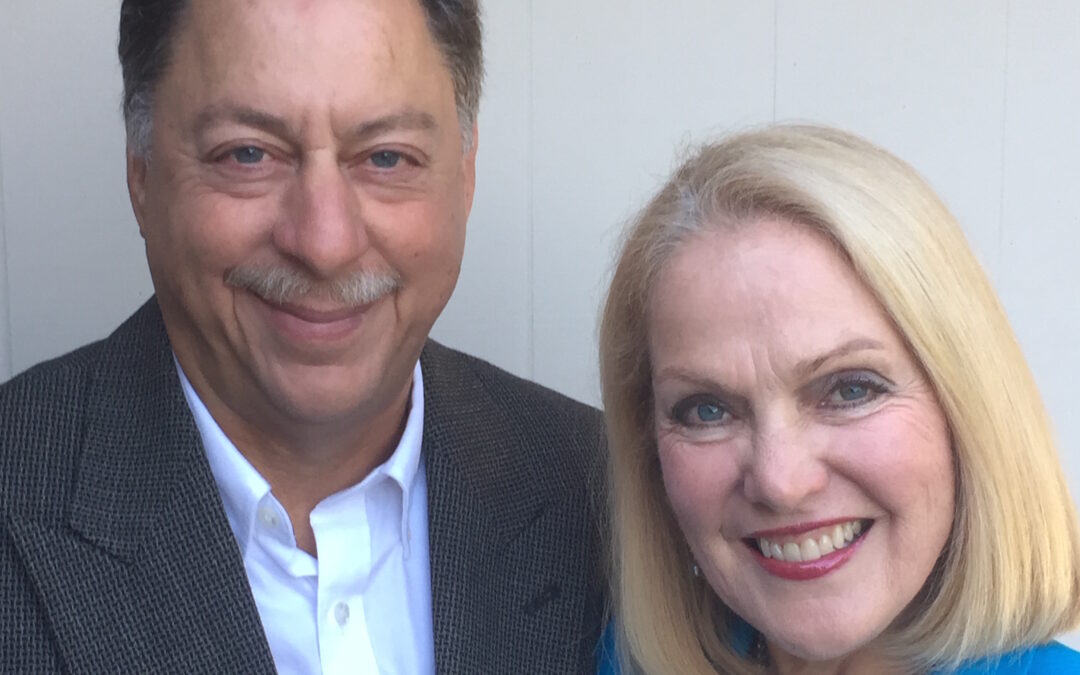
Jan 24, 2019 | aging, aging in place, declining health, diminished cognition, elderly, financial advisors, health, long term care, resources for seniors

Jan 18, 2019 | aging, aging in place, aging investor, cost of aging, declining health, elderly, finances for elders, financial advisors, handling money for aging parents, handling money for seniors, health, long term care, resources for seniors, retirement planning, seniors finances
Most advisors who even ask this question of their
retirement-aged clients never spend time on it. About 90% of those asked say
they want to remain in their own homes as long as possible. That sounds fine. Until one faces physical
decline, cognitive impairment or both. The advisor providing competent guidance
about financing aging at home had better know the facts.
None of us like to think about losing physical ability or needing help. We abhor the thought of losing our total independence. In our view at AgingInvestor.com, the only advice clients are getting is about the long term picture is whether or not to purchase long term care insurance. Since most people don’t do that, the actual costs of living at home can boggle the mind. It’s the best advisor’s obligation to educate your client about the risks of the plan to age in place, just as it is your obligation to educate them about balancing their portfolios. You are giving the client added value if you take the time to talk them through the risks and dollars they may need to have available.
Here are some briefly stated facts from a real case in which
an 89 year old wanted to age in place and his wife promised he would never have
to leave home.
At the outset of his declining health, he had about $3M in
invested assets. His portfolio was healthy and balanced for his age, according
to conventional wisdom. He began to lose his ability to walk due to multiple
medical problems. His wife hired home helpers, three days a week at first. As
his conditions progressed he needed more and more help. He had to have a wheelchair, and a special
van. A stair chair was installed in their two-story home. By the time he
reached age 95, he was spending over $150,000 a year on care and assistance
around the clock. In the space of time during which he was steadily losing
independence until he passed away at 95, his assets were depleted to the tune
of $2M. He lived in a higher end market for the needed help but the reality is
that in any market, the kind of care he needed would be very expensive.
For him, aging in place was more costly than a skilled
nursing facility would have been. Home modifications, private caregivers, (none
of whom were licensed nurses), equipment, medications, adaptive devices, etc.
drained his resources by 2/3. And not everyone has as much invested as he had
to even start the journey. His wife had her own assets and she paid the cost of
household maintenance, taxes, food, and utilities with her funds. Had she
relied on him for those things too, there would likely have been little left at
the end of his life.
It is not all doom and gloom however. Many clients live rather well in their last years without all the care this gentleman needed. Some get by with family caregiving help, and some have fewer medical conditions. But if you are going to competently help your clients plan for longevity, it’s essential to understand the real out of pocket costs of aging in place or anywhere else outside the home. If you want to add value to your services to older clients, know what they need to know to properly anticipate what can happen with living into one’s 90s and beyond. Learn all the actual costs of care for every aging client option in our book, Hidden Truths About Retirement & Long Term Care. Be well prepared to walk your client through the scenarios they could face in their futures. You distinguish yourself from other advisors when you sharpen your knowledge in planning for longevity.
By Carolyn Rosenblatt, RN, Attorney, AgingInvestor.com

Nov 15, 2018 | aging, aging investor, cost of aging, cost of long term care, custodial care, declining health, elder investor, elderly, finances for elders, financial advisors, financial capacity, financial judgement, handling money for aging parents, handling money for seniors, health, investor, long term care, seniors finances
Your clients are getting ready for retirement. You’ve done the calculations, balanced the portfolio and advised them of what income to expect. You’ve discussed how much spending is ok. You used your program and your analysis was thorough. You’ve done your job, right?
Not exactly. There is probably no algorithm nor program that will calculate your client’s individual profile of health risks that will likely lead to the expense of long term care. That can be a whopper. Maybe you’ve suggested long term care insurance. Most people don’t choose to buy it. For those who do, the benefits are limited and the “elimination period” (deductible) is thousands of dollars. There go your careful calculations. At least 90% of folks don’t have that coverage. Now what?
But how can you predict what’s going to happen to anyone’s health in retirement, you ask. You can’t be precise, but you surely can make some rational observations and give advice accordingly. Those observations consist of two parts: what you can see with your own eyes and what you can glean by asking a few basic questions. If you think asking any client about their health conditions is too nosy or not your job, consider that if the client needs long term care and runs out of money because of it, they’re not going to think much of you. And the cost can wipe out their security.
Asking about health issues is not nosy at all. Rather, it’s what any smart advisor planning for longevity must do. Let’s not keep pretending that everyone stays the same physically and mentally from the start of retirement to end of life. Our bodies go through wear and tear and things break down. Cognitive decline affects at least a third of people who reach the age of 85. The risk of Alzheimer’s disease keeps climbing after that. Now, what was that life expectancy you were using in your calculation? Was it age 99?
Let’s start with what you can see in your client with your own eyes. (If they’re not in front of you, perhaps Skype is an option). Is your client obese, as about 40% of the U.S. population is? This leads to heart disease, stroke, and diabetes, among other diseases and conditions. The medical care people receive in many cases will save them from dying but they then live with disabilities. And yes, they will be very likely to need expensive long term care. Neither health insurance nor Medicare will cover long term care. Such help as a part time caregiver at home is how most folks start out with long term care. Your client pays out of pocket most of the time. Did you calculate how much it costs as well as how long they will likely need it? If they have multiple medical conditions, and have started long term care, they’ll probably continue to need some form of it for all their remaining years.
Find out what you may not know from simply observing your client’s appearance by asking questions. You can make your own list or get a health care provider to help you with a few targeted questions. You will need to educate your client as to the reason why you need this information. It’s to help them plan for how much to save in their retirement years.
Here are some examples of basic questions that can help you predict the need for possible long term care:
- How’s your health these days? Has a doctor told you that you have any long term conditions?
- Are you taking medications? What are they for?
- Do you smoke?
- Are you concerned at all about any health issues you have at this time?
- Do you recall your parents’ ages when they died?
Your aging clients will not be eager to talk about the potential need for long term care. When you told them about what to expect for “out of pocket medical costs in retirement”, you did not give them a figure that included long term care. Long term care is not “medical” according to Medicare. Rather, it is called “custodial care”. The client probably will not bring it up, so you must do this.
When you have done your observations and gotten answers to your health-risk related questions at least there is a place to start a meaningful conversation. You can give them figures as to the cost of typical kinds of care, such as a non-medical home care worker. We at AgingInvestor.com recommend starting your projections at age 80 as to when a person might need physical help. Many of us know someone who did require help with at least some part of his or her life at that age. Then you can talk about how any condition your client identifies for you, such as high blood pressure, diabetes, etc. as shortening normal life expectancy and increasing the risk for needing help. If your client already has difficulty with some normal daily activity such as walking or bathing, they are definitely at high risk for needing paid help sooner than a person without these problems.
Clients may be completely unaware of such things as the hourly cost of a home care worker, what assisted living costs each month and what home modifications cost if they are able to remain in their own home. You can find a thorough discussion of these and many other parts of long term care in our book, Hidden Truths About Retirement & Long Term Care, written specifically for financial advisors like you.
Every conscientious advisor needs to wake up to the reality that your retirement income calculator omits the reality check of health problems. We’re not talking about nursing homes, but every other kind of care and help most people will need as they age. If you do want to help clients who are reaching retirement age to plan realistically, include the health risks you can see or learn about by asking.
By Carolyn L. Rosenblatt, RN, Elder law attorney, AgingInvestor.com

Apr 18, 2018 | aging, aging investor, diminished cognition, elder investor, elderly, finances for elders, financial advisors, financial capacity, financial elder abuse, financial judgement, handling money for aging parents, handling money for seniors, seniors finances
It seems that regulators are fond of creating new mandates for you without telling you how to implement them and what risks might be involved. The new FINRA rule that says you must “try” to get a trusted contact person (TCP) for new clients is illustrative.
First of all there is no firm requirement that you actually get a TCP for anyone. All you have to do is make an attempt. If the client says “no”, you’re out of luck in trying to solve any problem that may exist without anyone to call in the event of an issue you see. Such issues might include someone ripping off your client or your client really losing his marbles. The intent of the rule was good. The idea was to increase protections for vulnerable elders. It’s just that the way clients act and the issues you are sure to see with one TCP have been ignored in regulators’ creation of this mandate.
Research has given us important information about protecting elders from financial abuse. We know that family members are the most frequent abusers of elders. Guess who most elders would think of as a TCP? The family member, of course. The idea of a single TCP is flawed from the outset. If the idea is to keep your client financially safer, you don’t want to be limited to the potential abuser as the TCP. That defeats the purpose.
Here at AgingInvestor.com we are on a mission to keep elders safer. We make every effort to fill in the blank places your regulators leave when they come up with a mandate like getting a TCP for your clients. Here are our recommendations on this subject and why we say what we say about TCPs.
First, we believe every advisor should not only “try” to get a TCP for every client–we think you should insist on it as a matter of your intelligent, proactive senior office policy. Every client, new and existing should be approached with a courteous, respectful explanation and request to name a TCP you can contact in case of need. You let clients know that you have a policy to protect them from potential predators who are out there trolling for your clients, particularly the seniors. You could write this explanation and request up and send it around or bring it up at every portfolio review.
Next, we recommend that you get not just one TCP for every client, but three. The reason for this is that since family members are often the abusers of vulnerable people, you need someone else to call if “sonny boy” is ripping off dad’s account and dad is too impaired to realize it. “Sonny boy” just might be the one TCP his dad, your client named and you would then be stuck with no way to protect your client in that situation. Someone outside the family would be ideal. This could be the estate attorney, a competent friend, or a clergy person your client trusts. Any of them would need to be able to intervene when learning of suspected financial abuse of your client. A third TCP could be another family member your client also sees as trustworthy. With information going from the advisor to three people at once, the risk of abuse is lessened and the chances of effective action in the event of abuse are increased.
Finally, we recommend that you consider all the risks involved in a decision to reach out to the TCP when you see red flags of diminished capacity in your client, or when you see warning signs of financial abuse of your client. You do need a written internal office policy that directs you as to the observations, documentation and steps to take when an issue comes to your attention. Legally, you are probably on firm ground, carrying out the intent of the FINRA regulation. However, you don’t want to set your client up for harm.
For instance, if the client is in the middle of a contentious divorce and the ex- spouse is the TCP, do you want to release information about your client’s finances that could harm your client in the divorce proceeding? Give yourself time to discuss the options with other, knowledgeable people in your office, or group. The value of having a proactive office policy for aging clients in this situation is that you have others to ask and weigh in with their points of view.
If you are not sure about the red flags of diminished capacity and what you should look for, get your free downloadable checklist here. Likewise if you are not clear about classic warning signs of financial abuse get your free checklist for those here too.
Need help with that smart, proactive senior office policy? Ask for a consultation at AgingInvestor.com and get the guidance you need from our nurse-lawyer, geriatric psychologist team
Carolyn Rosenblatt, RN, Elder law attorney, AgingInvestor.com
<p><code> </code></p><div class="signature"><table style="border: 2px solid #999; border-style: solid; background-color: #f5fff5;"><tbody><tr><td style="width: 110px; vertical-align: text-top; align-content: center;"><div style="border: 1px solid #eee;"><img class="alignleft" src="http://www.aginginvestor.com/wp-content/uploads/2015/04/DavisRosenblattPublicityPhoto.jpg" alt="" width="123" height="116"></div></td><td><h4>Dr. Mikol Davis and Carolyn Rosenblatt, co-founders of AgingInvestor.com</h4><p>Carolyn Rosenblatt, RN, Elder Law Attorney offers a wealth of experience with aging to help you create tools so you can skillfully manage your aging clients. You will understand your rights and theirs so you can stay safe and keep them safe too.</p><p>Dr. Mikol Davis, Psychologist, Gerontologist offers depth of knowledge about diminished financial capacity in older adults to help you strategize best practices so you can protect your vulnerable aging clients.</p><p><a href="http://www.aginginvestor.com" target="_blank" rel="noopener">AgingInvestors.com</a> offers accredited cutting edge on-line continuing education courses for financial professionals wanting to expand their expertise in best practices for their aging clients. To learn more about our courses click <a href="https://agingparents.leadpages.co/ceu-choices/" target="_blank" rel="noopener">HERE</a></p></td></tr></tbody></table></div>

Feb 13, 2018 | aging, aging investor, cost of aging, elder investor, finances for elders, financial advisors, financial capacity, financial elder abuse, financial judgement, finra, handling money for aging parents, handling money for seniors, investor, power of attorney, senior investor, seniors finances
The regulators are trying. They want to help advisors protect aging clients from financial abuse. They don’t want you to fear doing something wrong if you refrain from handing over assets to what looks like an abuser. But not living in the real world of how to stop abuse by determined abusers has its disadvantages. The new rule tells you who is at risk (elders and other impaired adults). It tells you that you just need a reasonable suspicion of abuse, not unquestioned evidence. It tells you what a temporary hold is and how long it can be: 15 days, 25 at max. Sounds ok. Until you actually know how long it takes for the legal steps to halt abuse.
Here at AgingInvestor.com we see this problem in the world of families and those who want to rip them off, not from inside an institutional setting or financial services firm. The world from here looks different from what FINRA imagines. There is usually no way anyone can stop abuse in 15 days or even in 25. We explain. In a real case, the kind this rule is designed to affect, we worked with family in an unfortunately typical situation of an unscrupulous son trying to squeeze money out of his 90 year old father who had dementia. The advisor had seen the pattern. He knew the son never did well on his own and he had been given handouts from dad for years. Dad, whom we’ll call Joe, lived in a nursing home. He needed help with everything and his memory was shot. He was easily confused. Yet his advisor never questioned his ability to effect financial transactions. But when the son, we’ll call Jake, brought his frail father into the advisor’s office demanding $50,000 plus access to the cash management account, the advisor was sure it was abuse. He knew his client was too confused to disagree with Jake. The advisor dragged his feet and didn’t provide the check his client had asked for, pushed by Jake, Over a month later, he felt obligated to give his client the $50K, which of course Jake got right away from Joe. The advisor didn’t have Rule 2165 but he knew that Joe’s daughter Rhoda was the appointed person as power of attorney and successor trustee. He didn’t have permission to contact her, so he did it, as he said “on the QT”. Rhoda was upset. She called us for advice. She found us through her own advisor who had the sense to send her to a resource who could answer her questions and guide her.
First we looked at the trust and what it said about Joe being removed as trustee or resigning as such. Two doctor’s letters were needed, verifying that he was no longer competent to manage finances if he was to be removed as trustee. We advised her to get those letters asap. Rhoda lived out of state from Joe. She found the doctors and flew into town to take him to the appointments. Fortunately the doctors were able to say that Joe had indeed lost his capacity for handling his money. A couple of weeks after the appointments, Rhoda got the letters she needed. She then had to take them to Joe’s estate planning attorney, who met with her and eventually gave her a Certificate of Trust, showing that she was now the successor to Joe and was in charge of his money. She then had to get the Certificate to his advisor’s firm, which had to review it and after two weeks, they accepted it. Only then was Rhoda able to stop any further disbursements from Joe’s account without her permission. Her brother was furious. His gravy train had stopped. The advisor had sent a debit card for the cash management account Joe requested under pressure to Rhoda, not to Joe. Rhoda destroyed it. Abuse stopped in its tracks.
Reality check: this scenario of stopping abuse involved a lawyer, an elder willing to go to two doctors, the cooperation of two doctors, travel between states, the approval of the Certificate of Trust with Rhoda’s name on it through a process by the advisor’s firm and a lot of time spent by Rhoda. The entire matter of protecting Joe from abuse took three months. Rule 2165 supposedly authorizes advisors to “take immediate action” when abuse is reasonably suspected. What is myth rather than reality is how long it takes to actually protect the elder and stop a predator. This was a case of undue influence by Jake who had a history of manipulating his father. And the new rule would not have helped at all. Jake would have happily waited for a mere 15 days to get his hands on the cash. Rhoda couldn’t possibly get Joe removed as his own trustee without the doctors’ letters. This sort of prerequisite of needing doctors to verify incapacity is commonly required in typical trusts. Perhaps the drafters of Rule 2165 never had to go through the process described here in their own lives. If they had, the new rule would provide for a 90 day authorization to hold transactions, rather than a maximum of 25 days. Maybe going forward when the myth gives way to reality, the rule will be revised. For now it is inadequate.
|
|
Dr. Mikol Davis and Carolyn Rosenblatt, co-founders of AgingInvestor.com
Carolyn Rosenblatt, RN, Elder Law Attorney offers a wealth of experience with aging to help you create tools so you can skillfully manage your aging clients. You will understand your rights and theirs so you can stay safe and keep them safe too.
Dr. Mikol Davis, Psychologist, Gerontologist offers in depth of knowledge about diminished financial capacity in older adults to help you strategize best practices so you can protect your vulnerable aging clients.
They are the authors of "Succeed With Senior Clients: A Financial Advisors Guide To Best Practice," and "Hidden Truths About Retirement And Long Term Care," available at AgingInvestor.com offers accredited cutting edge on-line continuing education courses for financial professionals wanting to expand their expertise in best practices for their aging clients. To learn more about our courses click HERE
|

Feb 2, 2018 | aging, aging investor, declining health, diminished cognition, elder investor, elderly, finances for elders, financial advisors, financial capacity, financial elder abuse, financial judgement, scammers, seniors finances
You may have heard of the fake calls from thieves pretending to be from the IRS. It can be a threatening robocall. Or it can be a male with an aggressive manner telling the recipient of the call that they will be arrested for owing back taxes if they don’t pay immediately. These criminals carefully select older people and anyone they consider vulnerable to their fake pressure. Your aging clients could be a target and scammers want to terrify them.
How do they get the names of our aging parents? They buy them. Information is for sale, from lottery entry forms, contests, magazine subscriptions and from hacking whatever can be hacked. Identity information can even be purchased on the black market. “Information brokers” have been around for decades and so have these telephone scams. Supposedly, the entities that sell the names don’t care what the buyer does with them. There are likely millions of names and telephone numbers available to the scammers, given the nationwide nature of their ripoff efforts. Apparently, names and numbers are very easy for them to get.
Here’s how it works: The caller catches the unsuspecting older person off guard. The call is official sounding: “This is Officer James with the Internal Revenue Service and I am calling about an urgent matter! Do not hang up!” Sometimes they are even able to secure a fake caller ID that says “IRS” or looks like a legitimate government entity to those with caller ID. There were also reported cases when they used the name and email address of a CFPB employee.
They then tell the stunned elder that they or their spouse has an overdue debt to the IRS and if it is not paid immediately they will be arrested. Of course, they want the elder to use a wire transfer or a prepaid debit card so the thief can’t be traced. The frightened person will hurriedly comply and realize only later that it was a scam. In the moment of reacting to the threat, they are not thinking clearly. They are moved by fear–just what the thief was hoping for.
No matter how many public service announcements are sent out, and no matter how many Federal Trade Commission, AARP or National Center on Elder Abuse warnings are posted, the scam is still working. We at AgingParents.com think the best way to keep our aging loved ones financially safer is to personally warn them yourself about these scams. They will probably listen to family more readily than they would seek information from the internet or official sources trying to spread the word. Of course, the IRS will never, under any circumstances call someone and demand payment of a debt. Their official communications about taxes are by snail mail.
If these evil scammers were not successful, they would stop doing this. But sadly, it works and they are relentless. My neighbors, many elders, have reported that they have gotten these calls this week. Beware. Please take the time to alert your loved ones to this problem. And don’t think your mentally alert aging loved one is too smart to fall for this. No one is immune from being shocked and intimidated by a sudden call. It can happen to anyone.
We at AgingInvestor.com think the best way to keep your older clients financially safer is to personally warn them yourself about these scams. They will probably listen to family more readily than they would seek information from the internet or official sources trying to spread the word. Of course, the IRS would never, under any circumstances call someone and demand payment of a debt. Their official communications about taxes are by snail mail and that is not likely to change anytime soon.
If these evil scammers were not successful, they would stop doing this. But sadly, it works and they are relentless. My own neighbors, many elders, have reported that they have gotten these calls this week. Beware. Please take the time to alert your clients to this problem. And don’t think your ever so sharp client is too smart to fall for this. No one is immune from being shocked and intimidated by a sudden call. It can happen to anyone.
If you want to send a friendly letter to your clients about this scam and don’t have time to put it together, we make it easy for you. Just go to this link and download a free pre-made letter to send out.
 Revise it with your name or firm name and you’ll look good by showing that you do care about their financial safety. You’ll never regret doing your part to thwart thieves and prevent financial elder abuse.
Revise it with your name or firm name and you’ll look good by showing that you do care about their financial safety. You’ll never regret doing your part to thwart thieves and prevent financial elder abuse.
|
|
Dr. Mikol Davis and Carolyn Rosenblatt, co-founders of AgingInvestor.com
Carolyn Rosenblatt, RN, Elder Law Attorney offers a wealth of experience with aging to help you create tools so you can skillfully manage your aging clients. You will understand your rights and theirs so you can stay safe and keep them safe too.
Dr. Mikol Davis, Psychologist, Gerontologist offers in depth of knowledge about diminished financial capacity in older adults to help you strategize best practices so you can protect your vulnerable aging clients.
They are the authors of "Succeed With Senior Clients: A Financial Advisors Guide To Best Practice," and "Hidden Truths About Retirement And Long Term Care," available at AgingInvestor.com offers accredited cutting edge on-line continuing education courses for financial professionals wanting to expand their expertise in best practices for their aging clients. To learn more about our courses click HERE
|

Dec 8, 2017 | aging, aging investor, Alzheimer's disease
The Federal Trade Commission makes every effort to warn consumers about the latest scams and the information is important. However, your investors are not likely to spend time browsing through the FTC website for scams. We at AgingInvestor.com are passing on a warning for you to share with your clients. We want them to love you for how much you take care of them. When they get a friendly letter or email from you, that shows you’re paying attention to them.
Let them know about the fake U.S. Marshal scam. Here’s how it works:
The scammers get phone numbers from lists of potential targets. It is no secret that telephone numbers of seniors, in particular, are bought and sold by unscrupulous people. This scam is not limited to elders, but they are especially vulnerable, having been raised to generally respect authority. The scammer has a fake phone ID and number and perhaps even a real badge number stolen from the Marshal’s office. So your client might have caller ID and see “U.S. Marshal” on it. It’s intended to scare them. It works.
The caller says the target is delinquent in reporting for jury duty and there is a fine due immediately which must be paid. The caller threatens that the Marshal will arrest the target if he or she does not pay immediately. Of course, there is no such consequence for failing to report for jury duty and there was no summons for Federal jury service the target ever got. Never mind that, the target reacts out of fear.
When we react out of fear, we’re not logical. Why would a U.S. Marshal insist that anyone buy a pre-paid gift card for cash or wire money? That never happens. This may sound very obviously phony to you, but your aging client can be fooled by it. Perhaps the client is a bit forgetful and is terrified that he forgot about a jury summons. Or she thinks she is about to be taken away and she complies, feeling she has no choice but going to jail.
The takeaway is this. Please send a communication to all your clients that warns them of this scam and advises that you are looking out for their financial safety. You need to tell them:
- Don’t ever wire money or buy a prepaid card for anyone who contacts you by phone making threats, no matter who they say they are.
- Thieves get phony caller ID and can look real but they are not.
- Never give out any personal information such as your address, date of birth, your credit card number, your social security number or any other private data to a caller. If you call a company on your own and need to give this information that’s different. If anyone calls you and asks for it, hang up.
Your client can report attempts made by scammers to the Federal Trade Commission online. However, these thieves are hard to catch. They change states and phone numbers faster than law enforcement can track them. Finally, do not, as a financial advisor, assume that your smart, educated or savvy clients would never fall for these phony calls. Over $36B is stolen from elders every year in this country. Even the smartest people can be caught off guard. Warning everyone is a small thing but could save one of your clients from painful loss and ID theft.
We have form letters you can use, YouTube videos and lots of other tips to help you help the older clients in your book. Check us out at AgingInvestor.com.
|
|
Dr. Mikol Davis and Carolyn Rosenblatt, co-founders of AgingInvestor.com
Carolyn Rosenblatt, RN, Elder Law Attorney offers a wealth of experience with aging to help you create tools so you can skillfully manage your aging clients. You will understand your rights and theirs so you can stay safe and keep them safe too.
Dr. Mikol Davis, Psychologist, Gerontologist offers in depth of knowledge about diminished financial capacity in older adults to help you strategize best practices so you can protect your vulnerable aging clients.
They are the authors of "Succeed With Senior Clients: A Financial Advisors Guide To Best Practice," and "Hidden Truths About Retirement And Long Term Care," available at AgingInvestor.com offers accredited cutting edge on-line continuing education courses for financial professionals wanting to expand their expertise in best practices for their aging clients. To learn more about our courses click HERE
|
Oct 12, 2017 | aging, aging investor, diminished cognition, elder investor, elderly, finances for elders, financial advisors, financial capacity, financial judgement, handling money for seniors, investor, NAPFA, senior citizen investor, senior investor, seniors finances
Watch a brief VIDEO about our presentation ⇓

Oct 6, 2017 | aging, aging investor
Some of your older clients do not have family or they have no family they trust. Some know that their adult kids don’t get along and if both are on the estate documents, fights will be inevitable. You worry that as they age, some clients are going to need help with finances and their trust management and they shouldn’t count on family. When a client names one’s best friend to serve in the role of successor trustee may sound fine when they’re 50 years old but it’s not so fine when they’re 90.
The successor trustee of your client’s estate can do a lot of good or harm when he or she takes on that role. The person appointed to be the agent of a durable power of attorney is also in a position of tremendous power. Who should serve in that capacity? Should it be family or a professional outside the family?
Most often, your client appoints adult children or trusted people in their lives for this job. The danger arises when the adult child appears to be motivated to steal money or manipulate the elder into giving or loaning it to him. If it is a best friend, and both are aging, there is no assurance that the friend will survive long enough to help when needed or be competent to do so.
I once had a widowed client, living alone, no family in the U.S. who had appointed her best friend to be her successor trustee. I asked my 89-year-old client about the friend. “She lives right down the street”, my client told me. When I asked how old the friend was, she told me “88. She’s really sharp though, even though her vision is going”. I suggested she find a licensed fiduciary to take her friend’s place.
This could be your client. Time to step in and get the client to change that original, now unrealistic plan.
When you, the financial advisor see situations with clients in your book who are aging, and you know they will need someone trustworthy to help them with managing their estate and finances, you need to act. Here are some basics every advisor should know and do.
1. Get to know your client’s estate planning attorney, with written permission to communicate with her from your client. That is simple. Ask whether the estate plan is updated. Find out if the successor trustee is reliable, or in financial difficulty with potential motivation to steal. Team up and work together. If there is no estate planning attorney, give your clients some names of reliable lawyers you know and encourage making an appointment right away.
2. Ask your client about their appointed agents on both the family trust and any power of attorney document. Invite them to a meeting. Discuss the future for your client with the agent(s), particularly long-term care issues, budget and resources the successor might have to manage over your client’s lifespan.
3. Know reputable professional fiduciaries in your area and keep their contact information handy so you can refer your client to a list of them. Fiduciaries are not all created equal. Some are very helpful and can protect a vulnerable client from financial harm. Others are just not competent to do the job and shouldn’t be in it. Choose and vet your list carefully.
To understand more about best ways to manage aging clients and keep them financially safer, check out our book, Succeed With Senior Clients: A Financial Advisor’s Guide to Best Practices. It’s a great start. And you can get up to 10 hours of CE credit for reading it! Get yours here.
|
|
Dr. Mikol Davis and Carolyn Rosenblatt, co-founders of AgingInvestor.com
Carolyn Rosenblatt, RN, Elder Law Attorney offers a wealth of experience with aging to help you create tools so you can skillfully manage your aging clients. You will understand your rights and theirs so you can stay safe and keep them safe too.
Dr. Mikol Davis, Psychologist, Gerontologist offers in depth of knowledge about diminished financial capacity in older adults to help you strategize best practices so you can protect your vulnerable aging clients.
They are the authors of "Succeed With Senior Clients: A Financial Advisors Guide To Best Practice," and "Hidden Truths About Retirement And Long Term Care," available at AgingInvestor.com offers accredited cutting edge on-line continuing education courses for financial professionals wanting to expand their expertise in best practices for their aging clients. To learn more about our courses click HERE
|

Sep 14, 2017 | aging, aging investor, cost of aging, custodial care, elder investor, elderly, finances for elders, financial advisors, nursing home, senior investor, seniors finances, wealth transfer
You’re trying to help the sixty-something clients plan for what they can anticipate spending for medical care in the future. You tell them about the average amounts a couple retiring at age 65 will need. The language seems fuzzy. Are you, the advisor, completely clear about what the term means when you say “out of pocket medical costs”?
That which is “medical” and what is paid by Medicare does not seem to be clear to many financial professionals we’ve interviewed. If you want to help your clients plan adequately for retirement, here are some critical points you need to make with them.
Medicare never paid for what it calls “custodial care”. This is not medical care by Medicare’s definition. It did not cover it in the past and it does not pay for it now. There is a distinct and very important difference between what it covers and what most people need over the long run in their retirement years. If your idea of “out of pocket medical costs” is hazy, let’s clear it up right now. This is a list of things Medicare doesn’t pay for, which just happen to be the most common things people need as they age. This is only a partial list.
Nursing home (“rehab”) after a limited number of days. The maximum coverage depends not on how sick the client is, nor how much help they really need due to such disabling conditions as a stroke, nor how they feel. It depends solely on what the nursing home administration decides about whether they are continuing to make the right kind of progress. That progress must require skilled care which can be nursing, physical, speech or occupational therapy. There may be 100 days available for coverage, but this does not mean that all of it will be covered or that the person will get that much in the rehab facility. If it is decided that there is not enough progress, the person’s care is termed “custodial” and they are cut off from Medicare.
Home Care. Millions of people who are released from a nursing home after surgery, an emergency or a fall, for example, need help at home either short term or long term. Medical events change us and can rob us of complete independence. There is a false belief around that Medicare will cover what you need if you have to have home care. This is true only for a very short time and only if skilled, licensed nurses or therapists are needed at home. Most of the time, a person is cut off from help when leaving a facility and has to pay for home care out of pocket. The national average hourly rate is $20, which can eat up one’s assets quickly in a fairly short time frame.
Help at home to stay out of a care facility. A lot of folks think they’ll live to be 100 years of age. No one discusses with them what it would mean to live that long without being completely independent. Help costs money. Many people assume that family or someone will take care of them if care is needed. But not everyone is willing to or capable to undertake what is often a serious burden. Even when family does take on caregiving, they need a break, and relief. Then help from outside must be hired. Without constant help many older people would have to be in a care facility. Does it make sense that when assets are largely all spent, Medicaid will pay for a nursing home but Medicaid will not pay for preventing the need for a nursing home, a far more economical alternative? Of course not, but that’s how it works.
The Takeaways
Fully two thirds of us will need long term care at some point in our lives. Unless the client is the rare one with long term care insurance, there is no way to pay for long term care other than to do so out of pocket. Sometimes this depletes all the client’s assets and leaves them with no choices in the last part of their lives. For those who live into their 90s and beyond, the need for some kind of long term care by family or a facility seems almost inevitable. Your clients need to stop pretending that it’s not going to happen to them, and you, the professional must steer them in the direction of saving and anticipating this need as much as you can. They will resist! Keep trying. Educate yourself first. You can get all the facts and figures you need to have a wise conversation with your older clients in our new book, Hidden Truths About Retirement & Long Term Care. Get your copy now and start adding value to those retirement discussions with your clients.
Click HERE to order.
By Carolyn Rosenblatt, RN, Elder law attorney, AgingInvestor.com
|
|
Dr. Mikol Davis and Carolyn Rosenblatt, co-founders of AgingInvestor.com
Carolyn Rosenblatt, RN, Elder Law Attorney offers a wealth of experience with aging to help you create tools so you can skillfully manage your aging clients. You will understand your rights and theirs so you can stay safe and keep them safe too.
Dr. Mikol Davis, Psychologist, Gerontologist offers in depth of knowledge about diminished financial capacity in older adults to help you strategize best practices so you can protect your vulnerable aging clients.
They are the authors of "Succeed With Senior Clients: A Financial Advisors Guide To Best Practice," and "Hidden Truths About Retirement And Long Term Care," available at AgingInvestor.com offers accredited cutting edge on-line continuing education courses for financial professionals wanting to expand their expertise in best practices for their aging clients. To learn more about our courses click HERE
|

Sep 13, 2017 | aging, aging investor, cost of long term care, finances for elders, financial advisors, senior investor
Most financial professionals see themselves doing fine in helping their clients plan ahead for retirement. And their clients are probably in for a nasty surprise no one is talking about. The professionals have done the calculations, used the algorithms, had the conversations about their clients’ goals. You may have forgotten something. Are you missing the elephant in the room: long term care?
At least a third of your clients are going to need it at some point. We’re not talking about nursing home care here. We’re talking about all the other out of pocket costs clients are not considering but that they will likely need as they age. Think about longevity today. Both men and women will probably live into their 80s at least. How many 85 year olds do you know who do not need any sort of help with anything in their lives? Not many, we’ll bet.
As the body ages, it is harder to see, hear, get around physically, drive, and manage households and finances. Help with all of those things is actually an out of pocket cost we consider to be long term care. Medicare calls it “custodial care”. That means all the kinds of support an aging person needs to stay out of a nursing home. The actual cost of a nursing home is another discussion altogether. When we talk about custodial care here we mean help with bathing, dressing, walking, eating, getting to the bathroom and getting out of bed onto a chair and back. These are called “activities of daily living” or ADLs. We are also talking about help with shopping, cooking, paying bills, cleaning the house and doing laundry. These are called “instrumental activities of daily living” or IADLs.
Your clients don’t want to think about needing help. In this country, we insist on believing that we will always be independent–it’s embedded in our culture and myths about aging. But those myths are not true. Independence declines with age for most of us. And help is expensive.
Consider that the averages you hear about do not address this at all when it comes to retirement planning. “The average couple age 65 will spend (fill in the blank here, anywhere from $265,000 to $400,000) on out of pocket medical expenses.” OK. Custodial care is NOT medical care. Medicare does not cover it. Health insurance, including Medigap coverage does not pay for it. Who then does? Some long term care insurance policies cover some of it, with restrictions. Otherwise, it’s all an out of pocket non-medical cost your client will have to cover. Imagine the costs when you calculate the “burn rate” of their retirement funds. Didn’t factor that in? It’s time for a second look at the plan.
if you have no idea how to calculate this or what your client’s chances are for needing to pay for any kind of long term care, you can learn the basics and the costs in our newest book. Get the facts quickly that will help you in Hidden Truths About Retirement and Long Term Care: The Financial Advisors’ Guide. Order your copy by clicking HERE.
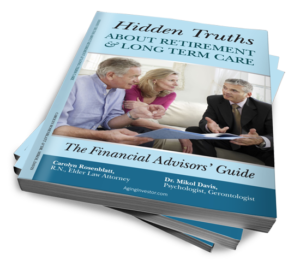
|
|
Dr. Mikol Davis and Carolyn Rosenblatt, co-founders of AgingInvestor.com
Carolyn Rosenblatt, RN, Elder Law Attorney offers a wealth of experience with aging to help you create tools so you can skillfully manage your aging clients. You will understand your rights and theirs so you can stay safe and keep them safe too.
Dr. Mikol Davis, Psychologist, Gerontologist offers in depth of knowledge about diminished financial capacity in older adults to help you strategize best practices so you can protect your vulnerable aging clients.
They are the authors of "Succeed With Senior Clients: A Financial Advisors Guide To Best Practice," and "Hidden Truths About Retirement And Long Term Care," available at AgingInvestor.com offers accredited cutting edge on-line continuing education courses for financial professionals wanting to expand their expertise in best practices for their aging clients. To learn more about our courses click HERE
|
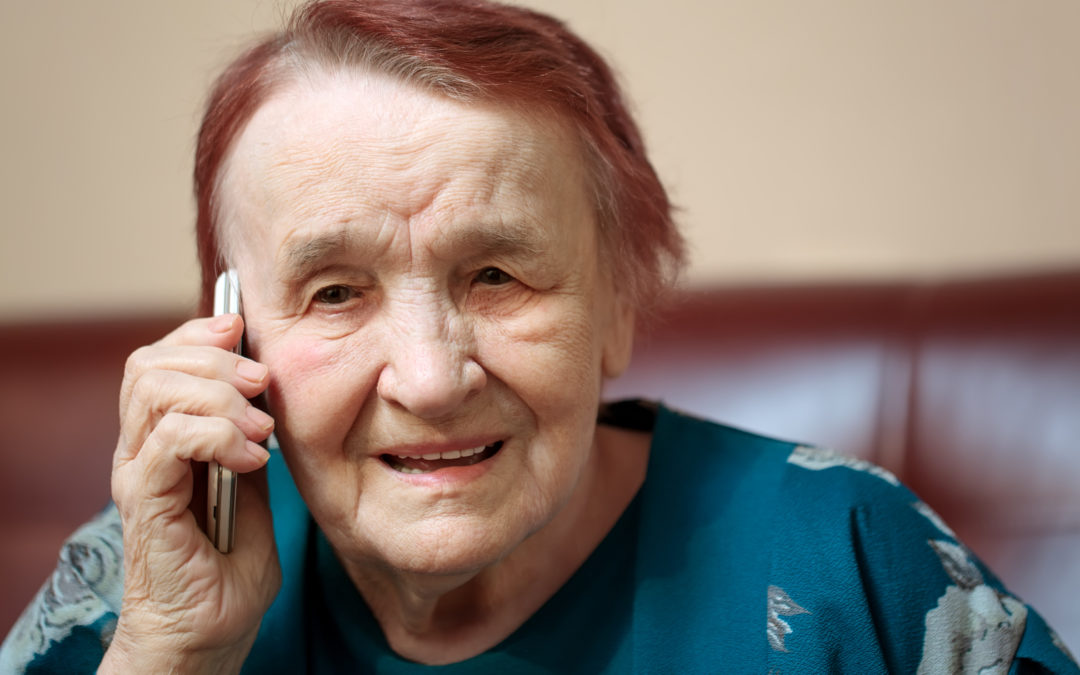
Jul 7, 2017 | aging, elderly, senior investor
Consider what you would do in this true case study. The advisor did not step up. Would you? Rhonda is 91 and lives independently. She has a few million in invested assets managed by her longtime advisor. Apparently, he forgot the requirement to “know your client”. Rhonda started playing the sweepstakes a year before things came to a crisis point. She got really excited about the prospect of winning. A scammer, who probably purchased her name from the sweepstakes companies, got in touch with her by phone. “You’ve won!” he exclaimed excitedly. He then went on to use a classic scammer’s trick. He told her she could get her million-dollar check if she would just pay the “fee” for transferring the funds. Sometimes the trick is paying the “taxes” or the “insurance fee”. It’s all the same. The scammer claims that they will deliver the check in person in exchange for the cash from the mark, often an elderly person. Luckily, Rhonda’s son found out and he and his brother tried hard to talk their mother out of this. She insisted that they didn’t understand and that “Mr. Banks” (don’t you love the name?) was a good person and he was going to deliver her winnings to her for real. No amount of reasoning could persuade her she was about to be victimized. Her son, Jamie called us at AgingParents.com. “What can I do?” he asked.
We had to act fast as “Mr. Banks” was coming the following week in person. Rhonda was still the trustee over her multi-millions despite the fact that she had been showing clear signs of cognitive impairment for over two years. No one had taken any steps to keep her safe until this crisis. We asked Jamie to get her trust and any estate planning documents ASAP. He did so. In reviewing them, I saw that he was a co-trustee on the trust. It also revealed that Jamie was the “attorney in fact” on mom’s Durable Power of Attorney and that he could act immediately. He got careful step-by-step instruction as to how to stop transactions on her accounts, and how to confront the nefarious “Mr. Banks” when he called to set up a time to meet with Rhonda. He also got advice about how to either get Rhonda to resign as trustee or to have her removed if she resisted. I personally called Rhonda’s financial advisor to let him know about the imminent abuse, that transactions should be held until either Rhonda resigned as trustee or until Jamie could put a stop to Rhonda’s attempts to get thousands of dollars for the predator. The options to stop his client would take a few days at least.
The advisor gave me a helpless-sounding response: “I don’t know of anything I can do”. Really? In the face of regulators insisting that you keep aging clients safer, that you address elder financial abuse and that next year you will be required to report abuse? Really? In the face of an upcoming regulation from FINRA that you can, in fact, hold transactions for two weeks in just this kind of situation? I was shocked at the lack of attention he paid to his own client’s risks. The outcome on this matter was successful. Jamie used the power of attorney to stop any transfers out of Rhonda’s account. She was too confused to argue with that action. When “Mr. Banks” called, Jamie was present and asked him “Who are you anyway?” Banks claimed he was a long lost relative and when Jamie told him to get lost, he actually did. Rhonda did not hear from him again. Whew, close call! The takeaways for advisors from this true case are these:
- Know your client. Diminished capacity leaves a trail. Stay in communication with your aging client’s family members, particularly those who are on their estate planning documents appointed to take over in the event of incapacity. Know them too.
- When you are informed of any clear case of imminent abuse, hold transactions. It’s that simple. Stop predators. Don’t play helpless. You do know what to do. See the compliance department of your organization if you are unsure about this. It should be clear – do what is necessary to keep your client safe!
- Recognize that your oldest clients, age 85 and up are at very high risk for dementia or diminished capacity. The risk is at least one in three. Some experts put it at 50%. Therefore, you need to be on the lookout for signs of diminished capacity and to have a plan in place to address it with those who are in the position to take other protective action. In the earliest stages of dementia, a person loses financial judgment and is a prime target for scammers of all kinds. Learn more about what you can do to stop financial abuse at AgingInvestor.com.
|
|
Dr. Mikol Davis and Carolyn Rosenblatt, co-founders of AgingInvestor.com
Carolyn Rosenblatt, RN, Elder Law Attorney offers a wealth of experience with aging to help you create tools so you can skillfully manage your aging clients. You will understand your rights and theirs so you can stay safe and keep them safe too.
Dr. Mikol Davis, Psychologist, Gerontologist offers in depth of knowledge about diminished financial capacity in older adults to help you strategize best practices so you can protect your vulnerable aging clients.
They are the authors of "Succeed With Senior Clients: A Financial Advisors Guide To Best Practice," and "Hidden Truths About Retirement And Long Term Care," available at AgingInvestor.com offers accredited cutting edge on-line continuing education courses for financial professionals wanting to expand their expertise in best practices for their aging clients. To learn more about our courses click HERE
|

Jun 20, 2017 | aging, aging investor, diminished cognition, elder investor, finances for elders, senior investor
Most financial advisors with aging clients often find themselves in the dilemma of just how involved they should get when it comes to their clients. You talk with them for portfolio reviews, but what if they show signs of diminished capacity in those conversations? Should you meet with them to talk about it or just wait until “something happens”? A critical point that every financial advisor needs to know: if your older client shows signs of mental decline, something is already happening. You don’t have the luxury of waiting. Research makes it clear that the ability to manage finances is the first thing to go downhill when a person begins to develop Alzheimer’s disease or other forms of dementia. There could be other reasons for cognitive decline too. Don’t make the mistake of ignoring it.
At AgingInvestor.com we recently heard a story that reinforces the importance of staying vigilant for your aging clients. Penny is 93 and until recently, the professionals in her life saw no particular reason to be concerned about her mental status. She was usually clear in conversation. Her accountant thought she was ok but failed to see mistakes and changes. But Penny was managing seven separate real estate investments and no one in her family, particularly her son, was helping her. Her son may have thought she was fully capable. She had been successful for decades. No one anticipated that she might become impaired late in life. But then her lawyer, living in a different city, wanted her to sign a document and have it notarized. She got confused and insisted that it be done incorrectly. The document came back a mess. Her lawyer did not heed these red flags that something was wrong and thought Penny was probably ok. He attributed the error to “normal” forgetfulness. Forgetfulness is a warning sign that closer monitoring of the older person needs to start right away.
Penny’s son eventually got her to a doctor who wrote a letter with the opinion that Penny was no longer able to manage her personal and financial affairs. Her son began taking over managing the property but was not prepared for what he found. Of the seven real estate holdings, five had IRS liens! One had become uninhabitable, the tenant had moved out and was billing Penny for the hotel stay, waiting for the home to be fixed. Penny had failed to pay the property taxes for several years.
Penny is a good example of a senior who is generally pretty clear but is definitely not able to handle complex finances any longer. The process of her cognitive decline did not happen overnight. It took several years. During that time she endangered her assets, lost track of her finances and could have lost most of her real estate to tax liens. Warning signs happened but no one paid attention to them.
Could this be prevented? Of course. Had her financial advisor kept a better eye on all of Penny’s assets, not just her stock account, he could have noticed the problem and contacted her son. The point is that wealthy clients may have assets you do not manage but also provide income. It is good practice to ask about all of your client’s holdings. Penny’s failure to pay property taxes and allowing the houses to fall into disrepair should have been seen by those close to her. Paying attention to those telltale signs of decline, which an alert advisor would have noticed, should have triggered reaching out to Penny’s trusted contact person. Working with your clients’ families is key to protecting their financial safety. Learn more about successful family meetings at AgingInvestor.com.
|
|
Dr. Mikol Davis and Carolyn Rosenblatt, co-founders of AgingInvestor.com
Carolyn Rosenblatt, RN, Elder Law Attorney offers a wealth of experience with aging to help you create tools so you can skillfully manage your aging clients. You will understand your rights and theirs so you can stay safe and keep them safe too.
Dr. Mikol Davis, Psychologist, Gerontologist offers in depth of knowledge about diminished financial capacity in older adults to help you strategize best practices so you can protect your vulnerable aging clients.
They are the authors of "Succeed With Senior Clients: A Financial Advisors Guide To Best Practice," and "Hidden Truths About Retirement And Long Term Care," available at AgingInvestor.com offers accredited cutting edge on-line continuing education courses for financial professionals wanting to expand their expertise in best practices for their aging clients. To learn more about our courses click HERE
|

Jun 15, 2017 | aging, aging investor, elder investor, elderly, finances for elders, financial elder abuse, senior investor, seniors finances
|
|
Dr. Mikol Davis and Carolyn Rosenblatt, co-founders of AgingInvestor.com
Carolyn Rosenblatt, RN, Elder Law Attorney offers a wealth of experience with aging to help you create tools so you can skillfully manage your aging clients. You will understand your rights and theirs so you can stay safe and keep them safe too.
Dr. Mikol Davis, Psychologist, Gerontologist offers in depth of knowledge about diminished financial capacity in older adults to help you strategize best practices so you can protect your vulnerable aging clients.
They are the authors of "Succeed With Senior Clients: A Financial Advisors Guide To Best Practice," and "Hidden Truths About Retirement And Long Term Care," available at AgingInvestor.com offers accredited cutting edge on-line continuing education courses for financial professionals wanting to expand their expertise in best practices for their aging clients. To learn more about our courses click HERE
|

May 26, 2017 | aging, aging investor, elderly, finances for elders, senior investor
While advisors are there to serve those with investable assets, it is not only your clients who are affected by politics, the Federal budget and cuts to programs. It may be your clients’ family members, their aging parents or struggling adult kids.
When family members are beneficiaries of various public programs that help them get by, your clients may not be affected except with feeling relief. But when programs are slashed, the reverberation can affect your own clients, who are likely to be better off financially and therefore expected to help. Every advisor needs to consider this. Cash flow projections on retirement savings can be totally disrupted when your client has to pitch in and give financial help to a low-income family member.
Imagine this: your Boomer clients are ready for retirement. You have carefully worked out what they will need to sustain their lifestyle and make their money last. One or the other of them has low income aging parents in their 80s. Their parents have part of their health care costs paid by Medicaid. Medicaid gets slashed. Your client has to help pay the 20% of costs Medicaid was previously covering for their parent’s health care costs. And since those costs tend to rise with aging, your client will potentially pay the cost of a supplemental insurance policy or non-covered medications or other things.
Here’s another thing to see in looking at how budget cut proposals can destroy your careful retirement income planning for your clients. Some have disabled siblings, adult children or others who benefited directly from the Medicaid expansion of the Affordable Care Act. Some of those folks are not yet eligible for Medicare and rely entirely on Medicaid for all health care coverage. With massive cuts to Medicaid, they are among the millions who would lose insurance altogether. If they have a well-to-do family member, your client, where will they look if a medical need arises and there is no way to pay for it? Probably to your client.
Then, lets look at your clients’ lowest income family members who rely on the Supplemental Nutrition Assistance Program (SNAP), formerly called food stamps. Nearly five million seniors rely on this program in order to afford food. A massive cut (proposed) of $194 billion would surely affect them immediately. Can you imagine any client refusing a request from a low-income family member for money because he or she couldn’t afford groceries? That grocery money contribution could be every week and go on indefinitely into the future.
Perhaps this is just a heads-up for every financial planner to build into clients’ retirement planning that some cash may be needed on a monthly basis to help their relatives who can’t get by without their help. In my own family, four of us pitch in every month to support a low-income sibling. He has Medicare and also Medicaid. For all of us who are Boomers and a bit older, a hit to the existing Medicaid benefit would cost each one of us more dollars every month than we are currently paying.
Your clients may be in the same situation. We at AgingInvestor.com hope you will bring up the subject and help your clients plan accordingly. You would do that by asking clients planning retirement if there is anyone in the family they may be called upon to help support.
Our political climate may not change for some time. And every lower income American who is a needy family member of your retirement-aged clients will be affected one way or another. Help them prepare for the anticipated expense.
|
|
Dr. Mikol Davis and Carolyn Rosenblatt, co-founders of AgingInvestor.com
Carolyn Rosenblatt, RN, Elder Law Attorney offers a wealth of experience with aging to help you create tools so you can skillfully manage your aging clients. You will understand your rights and theirs so you can stay safe and keep them safe too.
Dr. Mikol Davis, Psychologist, Gerontologist offers in depth of knowledge about diminished financial capacity in older adults to help you strategize best practices so you can protect your vulnerable aging clients.
They are the authors of "Succeed With Senior Clients: A Financial Advisors Guide To Best Practice," and "Hidden Truths About Retirement And Long Term Care," available at AgingInvestor.com offers accredited cutting edge on-line continuing education courses for financial professionals wanting to expand their expertise in best practices for their aging clients. To learn more about our courses click HERE
|
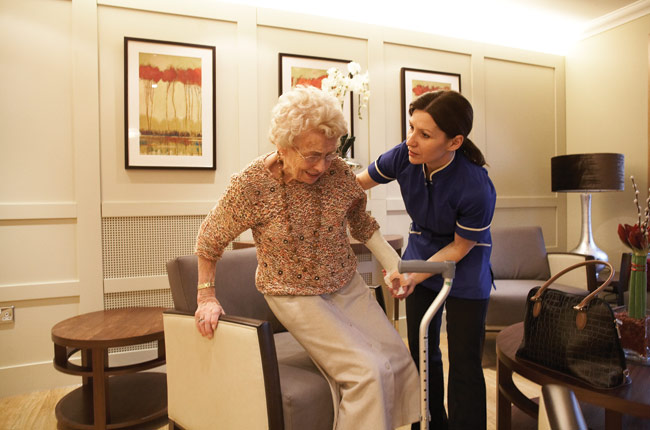
May 26, 2017 | aging, aging investor, elder investor, finances for elders, senior citizen investor
Mostly at the urging of their adult children, many seniors choose to move to senior communities where some help is available. These are usually called Assisted Living facilities (AL). When it is too difficult to keep up the family home or an elderly client of yours becomes too isolated after the loss of a spouse, AL can be a good choice.
No doubt you, the financial advisor have helped them consider the expense and the consequences or benefits of selling the family home. And they likely would not move if they could not afford the monthly cost of being in AL. However, there are things every advisor should know about AL so you can properly advise your clients.
The marketing departments of these homes can be very aggressive about promoting the benefits of AL. Indeed may of them are well appointed and have numerous convenient amenities. What they don’t tell you are the hidden disadvantages. Having interfaced with many of these facilities in our work at AgingParents.com and AgingInvestor.com as consultants to families, we want you to be fully informed of what they can and can’t do.
First, AL homes are not nursing homes, and they do not provide nursing or health care. If there is a nurse on staff at all, which is not required of any of them, the nurse is there to evaluate residents’ suitability, hear resident concerns, consult with staff and make referrals. It is not to provide direct care, even in an emergency. The nurse in such a facility, seeing an emergency, will call 911, just as any layperson might do.
These homes are not licensed to offer health care. Assistance with things like bathing, dressing, walking, bathroom, eating and getting in and out of bed are the limit of the help they can provide.
Next, these homes do not provide full staffing at night. If your client is forgetful or wanders around at night and her family shares this with you, AL may not be the best choice. Some people hire additional help privately to watch their loved ones in AL more closely, especially at night and this arrangement can work well. However, it is a significant additional expense and must be paid on top of the regular monthly charges of assisted living. We know of one resident whose family was spending $12,000 a month for the combination of AL and outside supplemental caregiving.
Finally, any home whether it is AL or any other place where care is delivered should be held accountable for the safety of your client who may become a resident there. No one is going to check on your aging client every hour in AL. Falls can happen anywhere, including a so-called “supervised environment”. The concept of AL was originally meant to give all levels of care but today that is not the case. The law requires separate licensing of any unit or facility that offers skilled nursing. Even when it is given on the same campus as AL, skilled nursing facilities are a separate entity from AL.
If you are talking to any client about the possibility of AL, be sure that your client is educated and that the family does not have unrealistic expectations of AL. The expense of these places is one consideration. The overall plan for the future of taking care of a client’s needs is another. Help your client be a wise consumer.
|
|
Dr. Mikol Davis and Carolyn Rosenblatt, co-founders of AgingInvestor.com
Carolyn Rosenblatt, RN, Elder Law Attorney offers a wealth of experience with aging to help you create tools so you can skillfully manage your aging clients. You will understand your rights and theirs so you can stay safe and keep them safe too.
Dr. Mikol Davis, Psychologist, Gerontologist offers in depth of knowledge about diminished financial capacity in older adults to help you strategize best practices so you can protect your vulnerable aging clients.
They are the authors of "Succeed With Senior Clients: A Financial Advisors Guide To Best Practice," and "Hidden Truths About Retirement And Long Term Care," available at AgingInvestor.com offers accredited cutting edge on-line continuing education courses for financial professionals wanting to expand their expertise in best practices for their aging clients. To learn more about our courses click HERE
|
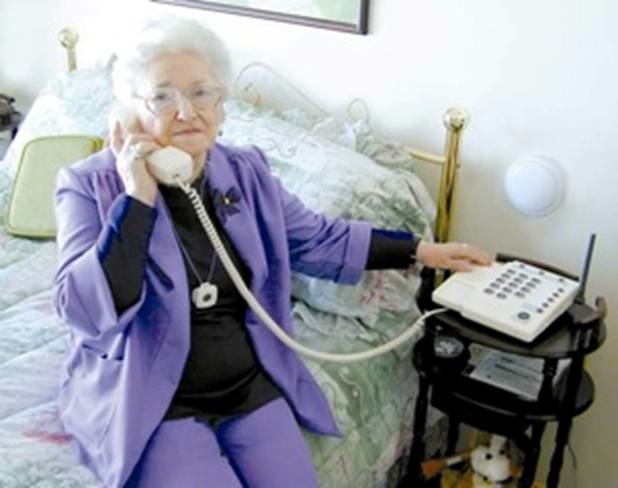
May 8, 2017 | aging, aging investor, declining health, elder investor, elderly, finances for elders, financial advisors, financial capacity, financial elder abuse, financial judgement, handling money for aging parents, senior citizen investor, senior investor, seniors finances
Your older investors are sure it will never happen to them but Medicare fraud can trick anyone. Even those without a hint of cognitive decline can get taken by scammers. At AgingInvestor.com, we educate advisors about protecting clients from elder financial abuse and we thought we had our own family covered. With a 94 year old mother, we are especially alert. We were stunned when mom told us that someone “from Medicare” had called and asked her to “verify” her personal information.
Alice is a sharp 94 year old, living mostly independently in a seniors’ complex. She’s active, does her own shopping and is engaged with her neighbors in the community. She had an issue with Medicare not paying a bill for a service she had received some months prior. With our help, she had undertaken an appeal process, which involves a lot of repetitive paperwork. When a man saying he was from Medicare called, she thought it was about the appeal. Of course it wasn’t. The scammer asked her to “verify” her Social Security number, her address, date of birth and mother’s maiden name and she gave him that information.
A few hours later, she mentioned what had happened and said she had been wondering if it was right to give out that information. We were shocked! How is it that she didn’t see the potential ID thief when we talk about this all the time? We knew we had to jump on this right away to stop the thieves from using the information to open new accounts in her name. Hours were spent the next day calling the two banks where she had accounts, her credit card company, the credit reporting agencies and Social Security. We had to stop the auto debits on her bill payments. We cleaned up the mess.
So far so good. No unauthorized transactions have happened. Her old accounts were closed and new ones opened. Social Security sends her payments to the new account. Fraud alerts are on everything now. Whew! This was a lesson that even the alert older person can get fooled with the right pitch on the phone.
Here’s the takeaway.
Warn your clients: Medicare will NEVER call and ask you for your personal information. Never give it out unless you place a call to order something that you know is legitimate.
Medicare fraud can happen in many forms. This was just one of them. I believe that there was probably a connection between her Medicare appeal and the fraud attempt. It’s too much of a coincidence that they called when she had communication with Medicare going on already with her appeal. The appeal had not yet been resolved. This information got into the wrong hands, making it easy to trick a sharp person by saying he was calling from Medicare. Mom could be just like any one of your older clients.
Why is this important? You’re on the front lines and you have a trusting relationship with clients. Speak up and make basic efforts to educate them about these scams. A lot of money can be drained from an account instantly with all the client’s personal information out there. Make yourself look good. A word from you can remind your aging clients that you care about their financial safety and that you are looking out for them.
Learn more about protecting aging clients from financial abuse in Succeed With Senior Clients: A Financial Advisor’s Guide to Best Practices. Click here to purchase it now. You’ll build your knowledge about aging investors fast.
Carolyn Rosenblatt, RN, Elder Law Attorney, & Dr. Mikol Davis, Psychologist, Gerontologist, co-founders AgingInvestor.com
|
|
Dr. Mikol Davis and Carolyn Rosenblatt, co-founders of AgingInvestor.com
Carolyn Rosenblatt, RN, Elder Law Attorney offers a wealth of experience with aging to help you create tools so you can skillfully manage your aging clients. You will understand your rights and theirs so you can stay safe and keep them safe too.
Dr. Mikol Davis, Psychologist, Gerontologist offers in depth of knowledge about diminished financial capacity in older adults to help you strategize best practices so you can protect your vulnerable aging clients.
They are the authors of "Succeed With Senior Clients: A Financial Advisors Guide To Best Practice," and "Hidden Truths About Retirement And Long Term Care," available at AgingInvestor.com offers accredited cutting edge on-line continuing education courses for financial professionals wanting to expand their expertise in best practices for their aging clients. To learn more about our courses click HERE
|

May 1, 2017 | aging, diminished cognition, elderly, finances for elders, financial advisors, financial judgement, handling money for aging parents, handling money for seniors, long term care, medicare, seniors finances
How Much Should You Plan On For Retirees’ “Out of Pocket Medical Costs”?
For those outside the caregiving world, there is a lot of confusion about this cost. Calculations abound in retirement planning circles for helping your clients ensure that they have enough for the things they are likely to need medically. The usual calculations outline Medicare Part A premiums (deducted from Social Security payments), Medicare Part B supplemental health insurance premiums, also called “Medigap” and for medication expenses, as some are not covered my Medicare. In plain English, this means that your client’s Social Security is less to them when the Medicare payment comes out and they have to pay out of pocket for the other kind of insurance that covers outpatient care, clinic and doctor visits, as well as prescription meds.
OK what’s wrong with these calculators? Can’t you rely on them? I think for an unusually healthy person who is your client, one who needs little care and has no chronic illnesses, they would be fine. I’m not sure where the folks making up the calculations get their statistics but I think they grossly underestimate the real costs of out of pocket medical care in retirement.
From personal experience with thousands of elders I visited at home as a nurse over a career, I did not see much of the unusually healthy. What I did see was the average person then taking numerous medications, having multiple chronic conditions and being at risk for those getting worse with age. And now, decades later, we live longer, have more health risks as a result of greater longevity and we have to pay more for the problems that go along with living to be 100. We have better diagnostics and we can catch and treat conditions more. That means more out of pocket expenses for those exotic tests Medicare will not cover. That also means more and more drugs being prescribed to manage and control chronic illness. They work, but we pay. You would be amazed at what Medicare does not cover.
Here’s the message I want every retirement planning advisor to heed: you cannot predict how much out of pocket medical expense your client will have unless you really know a lot about both their genetic disposition and their health habits and condition. And then it’s only an educated guess. How educated are you?
We do know that the way we age is about 30% due to our genetics. The other 70% of the picture is directed by how we choose to live. That means what we eat, how much we move our bodies, how we manage stress, how we socialize and how we succeed or not in our relationships with others. All of these factors affect our health and longevity and consequently, how much it’s going to cost to keep living with conditions like heart disease, diabetes, cancer, hypertension, arthritis, etc.
We haven’t even touched on the subject of Alzheimer’s disease. If you are calculating out of pocket medical I’ll bet you never calculate what it costs to care for someone at home 24/7 with specialized skill for dealing with this devastating disease. It can last 20 years. Nursing home care and caring for a person with any serious illness at home is long term care. That is not in the calculations in those handy tables describing the out of pocket medical costs for an average couple retiring at the age of 65 and living to be 85.
Here’s an example. Mort is 95. He has multiple health issues and early dementia. He can’t do anything by himself. He has 4 caregivers in shifts every day in his home. He isn’t sure he wants to keep going but he doesn’t want to stop the numerous medications he takes to stay alive. It costs over $250,000 a year just for the caregivers, not for the other costs of housing, utilities, transportation via handicap van and such. And the out of pocket medical is still there. The dentist, the hearing aids, the medications that no insurance pays for, the stair lift, the ramp on the front of the house, the high-end wheelchair and more.
If you want to help your clients plan so they won’t run out of assets, you’ll need to be realistic. Lots of cash may need to be available at the later end of life. It is more likely than not. Forget reliance on a calculator or use one that has the highest number you can find. Then add on expenses like Mort’s and you’re on the right track.
Get a lot more detail on caregiving, costs of care and what is needed as we age in The Family Guide to Aging Parents: Answers to Your Legal, Healthcare and Financial Questions. Check it out here.
Carolyn Rosenblatt, RN, Elder law attorney & Dr. Mikol Davis, Gerontologist
AgingInvestor.com and AgingParents.com
|
|
Dr. Mikol Davis and Carolyn Rosenblatt, co-founders of AgingInvestor.com
Carolyn Rosenblatt, RN, Elder Law Attorney offers a wealth of experience with aging to help you create tools so you can skillfully manage your aging clients. You will understand your rights and theirs so you can stay safe and keep them safe too.
Dr. Mikol Davis, Psychologist, Gerontologist offers in depth of knowledge about diminished financial capacity in older adults to help you strategize best practices so you can protect your vulnerable aging clients.
They are the authors of "Succeed With Senior Clients: A Financial Advisors Guide To Best Practice," and "Hidden Truths About Retirement And Long Term Care," available at AgingInvestor.com offers accredited cutting edge on-line continuing education courses for financial professionals wanting to expand their expertise in best practices for their aging clients. To learn more about our courses click HERE
|

Apr 24, 2017 | aging, aging investor, diminished cognition, elder investor, elderly, finances for elders, financial advisors, financial capacity, financial elder abuse, financial judgement, handling money for aging parents, handling money for seniors, investor, scammers, senior citizen investor, senior investor, seniors finances
What To Watch For: Aging Clients and The Sweetheart Scam
If it didn’t happen so often, there would be no need to warn your single, widowed clients about it. But every day, someone gets taken in by a “special someone” who appears to have only your client’s interests at heart. The special someone is a scam artist who knows just how to get an unsuspecting lonely man or woman into the web of deception. And then they finagle money out of your client and run.
Some of these scammers are skillful repeat offenders. Some just see an opportunity and proceed to milk it for all it’s worth. Take the case of Tommy, whose wife was ill with cancer. He used to take his clothes to the local dry cleaner every week and he got friendly with the woman who ran the business. She loved to chat and gossip and he was lonely with his caregiving, cooped up with the daily chores he had to do for his ailing wife. Norma, the dry cleaner heard all about it.
Just after his wife passed, Tommy got a visit from Norma. She was so consoling and comforting. He felt like he had a real friend. She had heard about his wife’s illness for over a year and was ever so sympathetic. She also knew he had money. Within a month she had moved in with Tommy.
Over the next six months of giving Tommy her undivided attention, she managed to persuade him to give her “loans” of over $300K. She promised to stay with him forever. He loved the flattery and feeling special. No sooner had Norma gotten the last of what she could easily take, she promptly sold the dry cleaning business and disappeared. This is not such an unusual story.
Here’s what every financial professional needs to know about the Sweetheart Scam. Professional predators comb the obituaries for stories about the beloved widow or widower left behind. They look for those who have been with a deceased who was a business leader, a banker, a financially successful person. They choose the ones who may be likely targets, the survivors who have means. They scope out how to meet them and seize the opportunity to take advantage of loneliness. They will stop at nothing to get in the door. And sooner or later they always need “a temporary loan” or a little help to get out of an unfortunate jam. If it works, they up the ante. This can go on until they have bankrupted a widow or widower. It will at least drain available cash if no one is watching.
That’s where you come in, the financial professional with the ability to notice when unusual withdrawals are coming out of your client’s account. Once the scammer has gotten control over your client’s emotions, it may be too late to stop the scam. Your client is “in love” or at least addicted to the showered on attention. She won’t believe your warning then. The heads-up must come early, before an opportunist has a chance to cast a spell.
Here’s the takeaway: any recently widowed client in your book is a potential target. Do these things:
- Gently raise the subject of being careful of any stranger he/she meets soon after the loss of a spouse. Warn with empathy and facts.
- If your client claims he’s met a “special someone” do some digging. Google the person he names. Ask a few probing questions. See what your client may not be able to see. Share the data you glean with your client.
- Be sure you have contact information for a family member or trusted friend of your client whom you can call if you see something suspicious. Call them if you think your client is in danger, particularly if your client doesn’t want to hear your warning.
That protective posture you take on can save your client from disaster.
Financial elder abuse takes many forms besides the Sweetheart Scam. It is called “the crime of the century”, it is so prevalent. With the right know-how, you can stop it and keep your clients safer. Take a deeper dive into this subject in a book written just for you, Succeed With Senior Clients: A Financial Advisor’s Guide to Best Practices. Get a look at it here.
Carolyn Rosenblatt, RN, Elder Law Attorney & Dr. Mikol Davis, Gerontologist
AgingInvestor.com and AgingParents.com
|
|
Dr. Mikol Davis and Carolyn Rosenblatt, co-founders of AgingInvestor.com
Carolyn Rosenblatt, RN, Elder Law Attorney offers a wealth of experience with aging to help you create tools so you can skillfully manage your aging clients. You will understand your rights and theirs so you can stay safe and keep them safe too.
Dr. Mikol Davis, Psychologist, Gerontologist offers in depth of knowledge about diminished financial capacity in older adults to help you strategize best practices so you can protect your vulnerable aging clients.
They are the authors of "Succeed With Senior Clients: A Financial Advisors Guide To Best Practice," and "Hidden Truths About Retirement And Long Term Care," available at AgingInvestor.com offers accredited cutting edge on-line continuing education courses for financial professionals wanting to expand their expertise in best practices for their aging clients. To learn more about our courses click HERE
|

Apr 17, 2017 | aging, declining health, elderly, financial capacity, financial judgement, handling money for aging parents, health, resources for senior, resources for seniors, Uncategorized
What To Do When Your Aging Client’s Health Is Failing
Financial professionals can find themselves in an uncomfortable position when they have a long time aging client who is in declining health. Of course, you know the client and can see that she’s struggling with a lot of issues. You may want to do something but this stuff is just not in your wheelhouse. Longevity is great but not when you start to lose the ability to manage on your own. What are you supposed to do for these clients?
You’re trained to understand economics, taxes, financial products, planning. But you’re not trained to direct aging people to whatever resources they may need as they get older. If they have family, you may expect family to step up, but you see that it may not be happening. Should you call them? Do you even know them? Do you have your client’s permission? And what if they don’t have family? That’s even worse. Here they are getting frail and more vulnerable by the day and you are just watching helplessly.
It doesn’t have to be that way. You can get acquainted with some basic resources in your area and the areas where your clients live. Maybe they never figured they’d live so long as to actually need help. When they do, you can be a starting point to help them find what’s out there.
Let’s imagine you have an aging client who is having trouble getting around and she needs some help with chores at home. She tells you about it when you ask her how things are going. She is shy to ask for help and reluctant to admit that it’s harder and harder to live alone. You don’t know what to say. Or do you?
One source of help everyone should know about is the Area Agency on Aging. These Federally funded programs connect elders to appropriate community organizations and places to get assistance. Their mission is to help older adults and people with disabilities live with dignity and choices in their homes and communities for as long as possible.
AAAs contract with local service providers to deliver many direct services, such as meals, transportation and in-home services. However, most agencies are direct providers of Information and Referral/Assistance, case management, benefits/health insurance counseling and family caregiver support programs.
Some are incorporated into a county’s health and human services departments. Some are separate. Large states have many AAAs. Smaller less populated states have fewer of them.
One thing you can do now to be ready to assist your own client who may demonstrate a need is to research where the nearest Area Agency on Aging is in your client’s community, download a brochure or information package and let your client know it’s there. If he needs help at home, transportation services, vetted information about local service providers, an AAA is a great place to start.
This whole aging client issue can be a reflection of things you have experienced in your own family. Perhaps you have an aging parent or ill grandparent. Another problem solving source of information is our book the Family Guide to Aging Parents: Answers to Your Legal, Healthcare and Financial Questions
. Learn what’s in it here. It can get you more comfortable with those difficult conversations.
Carolyn Rosenblatt, RN, Elder law attorney
AgingInvestor.com and AgingParents.com

Apr 11, 2017 | aging, aging investor, declining health, diminished cognition, elder investor, elderly, finances for elders, financial advisors, financial capacity, financial elder abuse, financial judgement, handling money for aging parents, handling money for seniors, senior citizen investor, senior investor, seniors finances
In a recent issue of Investment News, a study of financial advisors looked at this question. 591 advisors were asked about their experiences with elder financial abuse. One of the surprising findings focused on those advisors who knew or suspected abuse but did not report it.
A significant percentage of those who did not report abuse gave as a reason that they did not know who to contact. What is most troubling about this finding is that not knowing who to contact is such a simple problem to solve. Historically your regulators have never required that you have the name of a trusted contact for your client in order to open a file for that person. Here at AgingInvestor.com and AgingParents.com, where elder financial abuse comes up often, we think it is extremely short-sighted to be without a trusted contact or two in every client’s file. Isn’t it obvious that you need someone to call if a client gets into danger, whether it’s elder abuse or not? No one gets out of here alive and a client can live for quite a long time, developing cognitive impairment along the way. That puts a person at much higher risk for financial abuse.
New FINRA rules will require that you make “reasonable efforts” to get a trusted contact from your clients. We assure you, reasonable efforts are a lot easier to make when your client is signing up than they are when your client is 92 and forgetful or suspicious of everyone’s motives.
From us, two professionals who have worked with countless elders and their families over the last 10 years, we have three tips for every financial professional handling a client’s finances:
- You can’t ensure that your client will be competent for financial decisions forever. Be realistic! People are living longer and they may develop dementia or other cognitive impairment. Get at least two trusted contacts in every file for every client age 65 or older. Why two or more? One trusted contact might end up being the very person who is abusing your client–a family member.
- Get smart about the basics of recognizing red flags of diminished capacity. We offer a simple free checklist to help you. Click on the green button here to get yours now. These signs are warnings that your client is more vulnerable to manipulation by others.
- Know how to report financial elder abuse. You don’t have to be certain that abuse has occurred. You do need to know who may be doing it, when and how, in general (e.g., pushing your client into large, unexplained withdrawals). A reasonable suspicion is enough. It’s ok if you’re wrong. And you can do it anonymously. Call Adult Protective Services in the county where your client lives if you think someone is ripping off your vulnerable client.
Some advisors are worried that they’ll get sued for reporting suspected financial abuse. This is incorrect. Your regulators want you to report it. If you do what is reasonable, you are not a target. However, if you know that your impaired client is being financially abused and you do absolutely nothing, liability for failure to act is certainly possible.
by Carolyn Rosenblatt, RN, Elder Law Attorney, & Dr. Mikol Davis, Gerontologist, co-founders of AgingInvestor.com
|
|
Dr. Mikol Davis and Carolyn Rosenblatt, co-founders of AgingInvestor.com
Carolyn Rosenblatt, RN, Elder Law Attorney offers a wealth of experience with aging to help you create tools so you can skillfully manage your aging clients. You will understand your rights and theirs so you can stay safe and keep them safe too.
Dr. Mikol Davis, Psychologist, Gerontologist offers in depth of knowledge about diminished financial capacity in older adults to help you strategize best practices so you can protect your vulnerable aging clients.
They are the authors of "Succeed With Senior Clients: A Financial Advisors Guide To Best Practice," and "Hidden Truths About Retirement And Long Term Care," available at AgingInvestor.com offers accredited cutting edge on-line continuing education courses for financial professionals wanting to expand their expertise in best practices for their aging clients. To learn more about our courses click HERE
|




 by Carolyn L. Rosenblatt.
by Carolyn L. Rosenblatt.
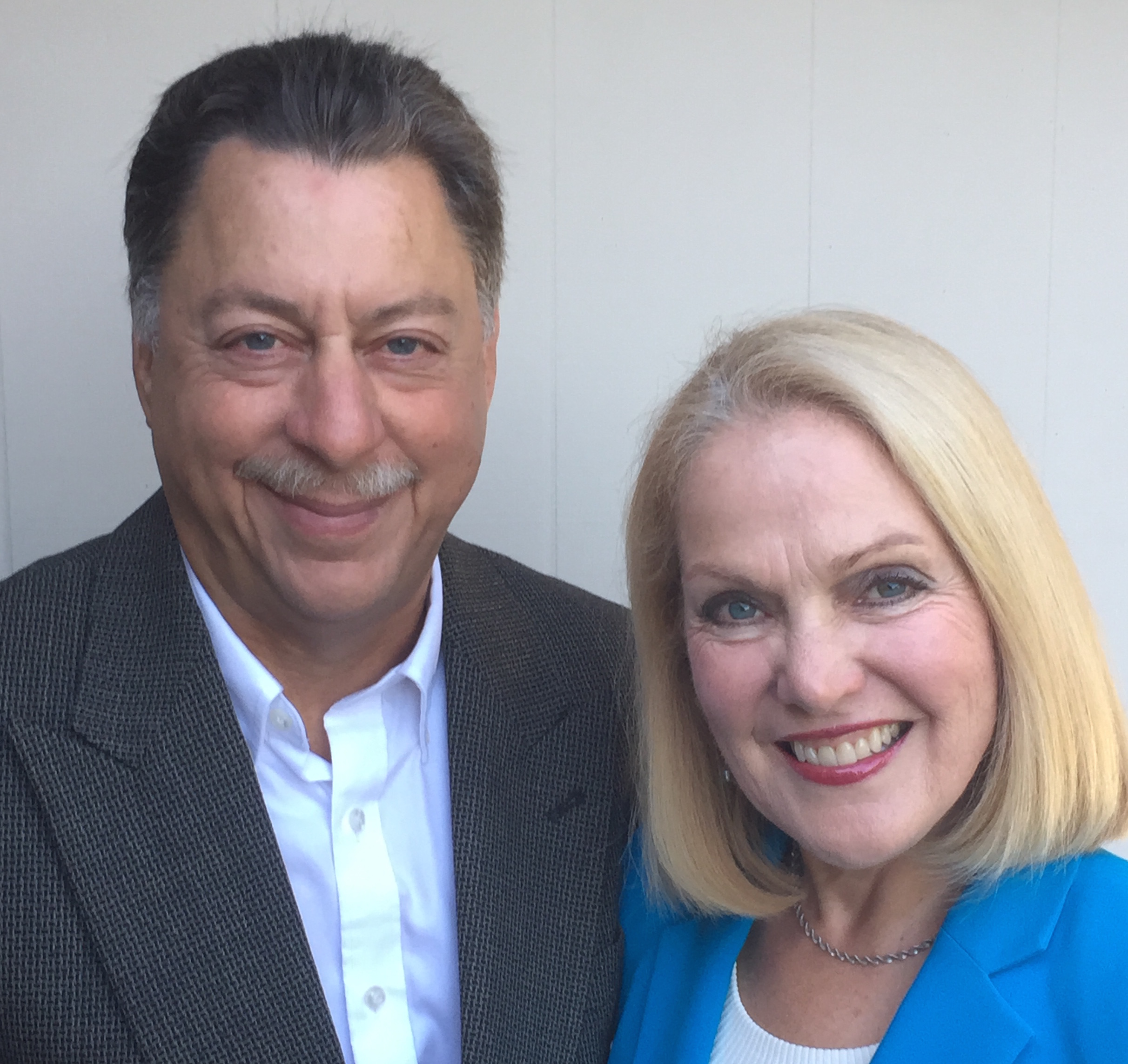


















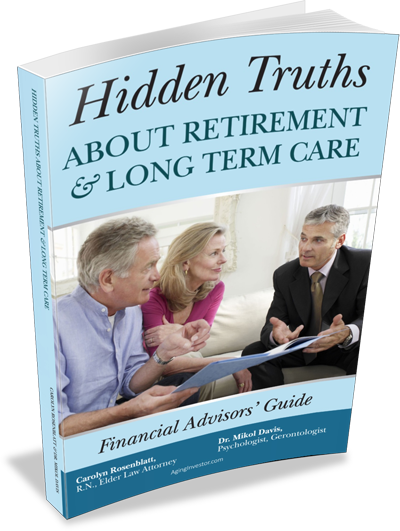




 Revise it with your name or firm name and you’ll look good by showing that you do care about their financial safety. You’ll never regret doing your part to thwart thieves and prevent financial elder abuse.
Revise it with your name or firm name and you’ll look good by showing that you do care about their financial safety. You’ll never regret doing your part to thwart thieves and prevent financial elder abuse.












